Market
market
Scale
The All In One Marketing Platform
Establishing the best pricing model is one of the most important parts of selling a membership – especially when it’s time to scale your business. The pricing structure lays the foundation for your marketing and sales strategy and impacts your students’ experience with your brand. And most obviously, your pricing model determines how your membership website will drive revenue.
Here are the nine best membership pricing strategies creators are using today.
A fixed-rate pricing model offers members a particular program, online course, or package of educational materials for a set price. Unlike a recurring membership or subscription model, this simple structure involves a one-time payment. If you offer a premium program at a high price point, the fixed price could also be divided into a series of installments.
The pros of a fixed-price offer center around its simplicity for both the creator—you!—and the member. An upfront, non-recurring charge is a straightforward model that gives members precisely what they expect. It also gives you a clear idea of how much profit each sale brings to your business. A flat rate is a great choice for creators with a simple business model and limited ability to produce new content quickly.
A major con of a one-time fee is that each new program or course you develop will require significant marketing efforts to encourage new purchases. You essentially have to start your sales cycle over again since you don’t receive recurring payments. Once a potential customer converts to a client, they may or may not purchase again.
There are a couple of different types of membership models. A lifetime membership model is similar to a fixed-rate model in that it involves an upfront fee or payment installment plan. However, instead of a one-for-one transaction, the membership model provides access to a variety of courses, materials, events, or any other content or services that you include. A term membership is another option that establishes parameters for this access. Term members would be granted access for a set period of time but would need to renew their membership for continued use of your platform.
A membership model encourages clients to become loyal followers of your brand instead of convincing them to make a particular purchase. It also allows you more freedom to create dynamic programs—as you update educational content, make improvements, and add new content media, paying members benefit from continued access to these materials without making separate purchases.
The downside of a membership pricing model is that your operating costs may outpace the price of the program or course as your business grows – leaving you with students whose membership dues are too low for the features they have access to. If you adjust the pricing, it can then be complicated to manage multiple categories of members who signed up for your courses at different price points.
Kartra’s membership site software combines everything creators need to build and manage a thriving online business, from drag-and-drop site builders and automated content dripping to comprehensive analytics and marketing tools. With zero transaction fees and seamless integration between your membership portal, email campaigns, and sales funnels, you can focus on creating content while Kartra handles all the technical details of running your membership business.
A subscription plan is one of the most popular pricing models for online programs and courses. It’s less commitment than a paid membership or a fixed charge, and it offers more flexible payment options – such as an annual or monthly plan. Best of all, collecting a recurring fee gives you a steady stream of income.
The main difficulty of a subscription model is that it requires content creators to continually produce more content to maintain user interest. Subscriptions are based on the expectation that annual or monthly fees will give users ongoing value that is worth their regular investment. And while subscription pricing can be very profitable for a business owner, you’ll need to monitor the impact of churn rates on your customer lifetime value and work to keep your retention rate high. For every member who cancels the subscription, you’ll need a new member to take their place.
The flexibility of tiered pricing makes it another popular approach to membership pricing. A range of membership offerings at different price points creates appeal with a broader variety of clients. Tiers can also help content creators have a stronger revenue stream by marketing certain features or courses as a premium option worth paying more for. Not every client will want the most expensive membership tier, but the ones who do will boost your revenue and be rewarded with the highest level of access.
A downside to multiple pricing tiers is that it can be complicated for a small business owner to develop and manage separate membership levels. Tiered pricing necessitates testing and adapting to land on the most strategic divisions for different audience types. You’ll also need to ensure that students at each tier get the right value from your membership according to the plan they chose, which is more labor intensive as you gain more students or offer more tiers.
A freemium isn’t a free trial but a basic version of your program that is free to all members. This strategy is popular with online course creators. A zero-commitment, free membership makes it easier to onboard new users, gives you a chance to prove your worth to your audience, and places leads into a sales funnel where they can choose additional paid features. A free course can be a strategic means of setting up a sales funnel with upsell sequences leading to your paid content.
The obvious downside of a free version is the cost of producing free content that may or may not result in a sale. Converting free customers to paid customers will take a strategic sales and marketing plan. A counterintuitive downside to a free version is that you can actually discourage users from signing up for your course by making it too accessible. Depending on the subject matter, your competition, and your target audience, a free course may come across as low-value. Many students subconsciously prefer a paid course based on the perception that their money will buy them a more valuable experience.
A build-your-own membership starts at a base price but lets students adapt their plan with individual add-ons. This a-la-carte pricing model allows for a more personalized user experience and could help your business stand out from the competition. Plus, setting individual prices for features instead of a bulk price may increase the profit margin of each offering.
The disadvantage of an add-on model is the complexity of developing and managing a wide range of clients and features. If you end up restructuring certain offerings or changing your prices, this can complicate things even further. And in terms of user experience, your students may or may not want the responsibility of picking and choosing add-ons. Sometimes a comprehensive plan provides a smoother customer experience – especially if your students aren’t aware of all the features they might need.
A usage-based pricing model charges members based on how much they actually use your content or services. This could mean paying per course completion, per download, or based on the number of times they access specific resources. This model is particularly effective for specialized educational content where students may want to pace their learning according to their schedule and budget.
The primary advantage of usage-based pricing is its inherent fairness – members only pay for what they use, which can make your offering more attractive to potential customers who are uncertain about committing to a larger package. This model also provides valuable data about which content is most valuable to your audience, helping you make informed decisions about future content development.
However, usage-based pricing can be challenging to implement effectively. It requires robust tracking systems to monitor member activity and calculate charges accurately. The unpredictable nature of revenue can also make it difficult to forecast income and plan for content development. Additionally, some members might feel pressure to restrict their usage to manage costs, potentially limiting their learning experience.
Competitor-based pricing sets your membership rates based on what similar creators or platforms in your market are charging. This pricing option requires thorough market research and a clear understanding of how your offering compares to others in terms of quality, comprehensiveness, and unique value proposition.
The main benefit of competitor-based pricing is that it helps ensure your rates are aligned with market expectations. If your pricing is significantly higher than competitors, you’ll need to clearly demonstrate superior value to potential members. If you price lower, you can potentially capture market share but need to ensure you’re still profitable. This model also simplifies the pricing decision process since you’re working with concrete reference points from your market.
The downside of competitor-based pricing is that it can lead to a race to the bottom if not managed carefully. You might be tempted to undercut competitors without fully considering your own costs and profit margins. Additionally, this model doesn’t account for unique aspects of your content or teaching methodology that might justify higher rates. There’s also a risk of basing your pricing on competitors who have different cost structures or business models, leading to unsustainable pricing for your specific situation.
Value-based pricing sets rates according to the perceived value and tangible benefits your membership provides to students. This approach focuses on outcomes rather than inputs – considering factors like potential income increase, career advancement, or personal development that members can achieve through your content.
The strength of this model lies in its alignment between price and actual student benefits. When you can clearly demonstrate how your content transforms lives or careers, premium pricing becomes easier to justify. This approach also encourages you to continuously improve your offering to maintain and increase its value proposition.
A challenge with value-based pricing is accurately quantifying the value of your content, especially for subjects with less tangible outcomes. You’ll need to invest in gathering success stories and metrics to support your pricing structure.
The value of membership is a fluid metric – subject to change based on your competition, consumer demand, and brand perception. And if you’ve been selling online courses or programs for a while now, it’s likely time to reassess how much you charge for them. Valuing your membership correctly is the first step before landing on a specific pricing model.
Keep in mind that as your business grows, your operating costs will, too. It typically takes more resources to break into new audiences and launch subsequent programs than to create and distribute your first one. Here are three important cost categories to re-evaluate as you choose the right price point for your services:
Your customer acquisition cost is the average expense you incur to convert a prospective member into a paying client. This includes all sales and marketing costs, such as social media advertising, discounts, or sales tools. Comparing your customer acquisition cost (CAC) to the customer lifetime value (LTV) helps you understand the profit you get from each new client based on your current methods for obtaining clients. (Customer lifetime value is the revenue you receive from someone over the whole length of time they are an active customer.)
Developing a membership program involves a number of hard costs – from the video equipment for filming material to the software you use to upload, edit, and publish content. Expenses related to working with third-party vendors, such as website designers or video editors, also fall under the cost of program creation. As your offerings grow, these expenses will likely increase.
Getting your content into the hands of members is its own category of expenses. Membership management software, marketing, shipping costs for course materials (if you are printing), and other aspects of course delivery quickly add up! Take inventory of each step you go through to publish course content, and be sure to itemize any additional costs involved.
The costs of producing content and marketing your membership can easily build up without you realizing it – especially as you add more members and scale your business. Make sure you don’t get so busy delivering content that you fail to revisit the numbers! Setting aside time to re-evaluate membership costs helps ensure your business is operating on correct premises.
Updating the pricing structure of your membership will require shifting aspects of your business operations. Here are three tips to keep in mind after you decide on a new pricing strategy:
Membership pricing plays a significant role in your marketing plan, and even acts as its own marketing tactic. For example, positioning an online course as a premium educational experience at a higher price will attract a very different audience than promoting one as an affordable monthly service. Or, if your program has a time-sensitive aspect to it, such as a membership with a term expiration, you’ll need to time your sales funnel accordingly – offering discounts for early sign-ups, promoting renewals, and using a sense of urgency as a sales tactic.
If you update your pricing model, you’ll need to update your marketing plan to align with this new approach. Your pricing strategy and marketing strategy should target the same audience, send the same message about your brand, and integrate seamlessly with your sales funnel.
Check out our guide: Everything You Need to Know to Market Your Online Course
As you grow and scale your business, don’t forget about existing members who have been following your brand since the beginning. Changing pricing models can alienate some of your most loyal followers if there isn’t a courteous process in place for bringing them into the new system. Some companies make a practice of grandfathering previous members into the new pricing model, allowing them to continue with their original, lower price. If your new model involves significantly improved features, consider how you can keep your customers educated and informed so they can see how the increased payment corresponds to the increased value they’ll receive.
As you assess the value and structure of your membership, take stock of the software and/or third-party vendors you use for creating, delivering, and promoting your course. These expenses add up over time and might complicate business operations more than you think.
Kartra’s all-in-one software offers a streamlined solution, letting creators develop, market, and manage their membership all within one single platform. This integration makes sure no one falls through the cracks, improves data analytics, and allows you to build a more consistent brand image. Plus, once you’ve consolidated your tools membership and marketing platforms into one powerful platform, you’ll be able to cancel all those extra software payments!
Develop and promote your online course in the same platform with Kartra’s all in one marketing and membership features.
Streamlining processes is a critical part of growing your membership business. Your time will only become more valuable as you produce additional content and engage with growing numbers of students. Spending less effort on day-to-day business operations helps maximize your schedule as well as your resources. If it’s time to establish a new pricing model for your course, consider how an all in one platform can help you scale your business with ease.
This blog is brought to you by Kartra, the all-in-one online business platform that gives you every essential marketing and sales tool you need to grow your business profitably – from sales pages and product carts to membership sites, help desks, affiliate management and more. To learn how you can quickly and easily leverage Kartra to boost your bottom-line, please visit kartra.com
Becoming an independent consultant is a career move with a lot of exciting opportunities. You set your own hours, take on the projects that you choose, and be the one who profits from your success. But you’re probably wondering: How much will I be able to make on my own? How much should I charge?
In this guide, we break down how to set a freelance consulting rate and look at four pricing models for consultants.
When you first go into business for yourself, it’s a challenge to figure out what your services are actually worth! You don’t want to undersell yourself and have your services perceived as low-value, but you don’t want to scare clients away with an overly high rate either.
The right price will accurately reflect the value you bring to your clients while enabling you to reach your financial goals. Getting to this number is a bit of an art as well as a science! It requires calculating hard numbers while also forming the right mindset about what you have to offer.
Before you get into pricing strategies, determine how much you need to make as a consultant. Identify the income that would accomplish your goals — whether you’re planning on replacing your full-time salary or starting a side hustle.
Once you know your desired “take-home” profit, you’ll have to factor in all the expenses that come with being a small business owner. There are a lot of hidden costs involved — typically covered by an employer — that have to be added up to give you an accurate picture.
Overhead costs for consultants include:
Next, determine your base hourly rate in view of your profit goal and anticipated expenses. Even if you don’t end up charging clients by the hour, knowing your base hourly rate helps you understand the value of your time and gives you a starting point to calculate project or retainer fees.
[Profit Goal + Yearly Expenses] / [Billable Hours] = [Base Hourly Rate]
Example: [$125,000 + $60,000] / 1200 hours* = $154/ hr
*24 billable hours per week, 50 weeks out of the year
Yearly wages are typically calculated assuming 40 paid hours in a week, 50 weeks of the year — coming to 2,000 annual work hours. As a freelance consultant, you’ll need to subtract hours to account for time spent working on your business and other time that isn’t billable.
Many consultants start their freelance journey by doing part-time consulting work on the side — often for a previous employer or someone in their network.
Start by examining your current compensation. Remember that a full-time employer pays more to have you on their team than what shows up on your paycheck! Factor in employer-sponsored benefits and the taxes paid by your employer to understand your actual hourly rate.
Once you understand your current compensation package, you can set a rate that makes sense for how many hours you’ll be working and any new expenses that you’ll incur.
And remember — you’re dedicating time outside of your normal work hours to offer consulting services. What is that time worth to you?
Learn about Kartra’s all-in-one marketing platform for consultants and coaches
Arriving at the number you need to make is only one piece of the puzzle. It’s essential to take a step back and assess the value you bring to the marketplace.
A good rate to charge for consulting comes down to how much value you provide your clients.
This is an important perspective shift for independent consultants, as it’s easy to undersell your worth. You are an expert, and people need your help — you deserve to be compensated for what you’re able to accomplish for your clients.
Here are a few questions to help you shift your mindset from service-based pricing to value-based pricing:
Building your consulting business around value will also position you to work with clients who share your perspective. Instead of catering to price shoppers, you can appeal to clients who want real results and who are willing to pay what those results are worth.
Your price as a consultant can’t be static. As you gain more experience as an independent consultant and navigate market changes, you have to be willing to adapt your price accordingly! A successful track record will drive up your value, and you may find that you’re able to maintain your income while charging higher rates for fewer contracts.
It’s also important to make a habit of reviewing your service packages for accuracy. Changes in your industry, or even in the economy, affect how much time you put into your projects and what business expenses you incur.
Does this project still take the same amount of time? Or does it demand more resources lately? Does my retainer fee reflect the support I provide my clients? Have my business expenses gone up this year?
Routinely asking these kinds of questions will help prevent you from losing your profit margin over time.
As a freelance consultant, not only can you set your own price for your consulting services, but you have the freedom to choose the best price structure for your business and clients. Here are four of the most popular pricing models used by consultants:
| Pricing Model | Advantage | Challenge |
|---|---|---|
| Hourly | Straightforward and flexible | Not scalable, focuses on time instead of value |
| Project | Scalable and value-based | Requires accurate estimation of time, effort, and resources |
| Retainer | Brings in consistent income | Clients must be willing to pay a recurring fee |
| Performance-based | Can be highly lucrative | Risky and difficult to implement |
Read on to learn more about the pros and cons of each fee structure. (And remember that you can offer multiple types of pricing models to accommodate different client needs.)
Charging clients by the hour is the basic pricing strategy where new consultants typically start. However, most consultants will eventually move beyond this strategy as their business grows.
Example: A project management consultant charges $200 per hour to oversee the implementation of a new software system for a healthcare organization. The hourly rate allows the client to scale the consultant’s involvement based on project needs, such as during key phases like system integration and employee training.
[Profit Goal + Expenses] / [Billable Hours] = Base Hourly Rate
To calculate your hourly rate, start by identifying your profit goal as a freelancer. Whether you work as a full-time independent consultant or this is your side hustle, determine the amount that will meet your needs. Next, factor in your expenses — from software costs to paid time off. Then divide the total revenue you need to earn by the number of billable hours you plan to work. This is your base hourly rate – the amount you have to charge to make sure you’re earning your goal income. From there, you can mark up your hourly rate to account for high-value projects, holiday hours, or other factors that influence your price.
Base Hourly Rate:
This straightforward pricing model compensates you for the amount of time that a project takes and affords flexibility for projects that are difficult to estimate ahead of time. Charging an hourly fee is common for short-term engagements where the client needs your expertise for a project that doesn’t require ongoing services. Even if you expand to other pricing methods, an hourly consulting rate can always be a helpful add-on to your usual project rate or monthly retainer fee.
Hourly services are very difficult to scale. You only have so many billable hours in a day — and if you intend to hire employees at some point, you will have more expenses than what can be covered by an hourly rate. This pricing strategy also risks tying your worth as a consultant to the number of hours that you spend working instead of the results that you get for your clients. Some projects won’t take a significant number of hours, but the quality of the work still demands a premium price!
Find out how to promote your consulting business in our guide
A project-based rate is one of the most popular pricing strategies, implemented by all types of consultants. This pricing model is based on deliverables — clients are charged a flat fee for a designated scope of work. The price you set for a consulting project should factor in how many hours you expect to spend on it, but unlike an hourly rate, project pricing doesn’t have to be calculated strictly based on time.
Example: A business consultant charges $20,000 to develop a market entry strategy for a company expanding into a new geographic region. The project scope includes market research, competitor analysis, and a detailed go-to-market plan.
[Hourly Rate] x [Estimated Billable Hours] + [Markup] = Project Fee
To calculate your project fee, multiply your hourly rate by the number of hours that you estimate the project will take. The estimated billable hours should include buffer time for unexpected complications. However, remember that your project fee is the price of the whole package. It doesn’t necessarily correspond to a specific number of hours. For example, you can mark up your fee for projects that demand a higher level of expertise or urgency.
This pricing structure gives you the freedom to set a rate that accurately reflects your value, regardless of time spent. The client is paying for an end result, not a specific number of hours! Charging by project also helps to factor in business expenses (especially if you add people to your team), since you don’t have to cover every cost through an hourly rate.
Unlike an hourly rate, which is flexible and open-ended, a project has a fixed scope and an upfront fee. This means you need to know the amount of work that a project will demand from you ahead of time so that you are compensated fairly. If you run into unanticipated complications, you can end up losing money on a project because it wasn’t estimated correctly!
A retainer pricing model involves charging an upfront fee for a set number of hours or tasks during a given time frame (often per month). Calculating a retainer fee works the same way as calculating an hourly or project rate, but the goal is to offer long-term consulting services. It’s common for consultants to offer a monthly retainer after they’ve established a relationship with a client and proven the value of their services.
Example: A financial consultant charges a monthly fee of $2,500 to provide ongoing advisory services for a mid-sized company’s cash flow management and investment strategies.
[Hourly Rate] x [Estimated Billable Hours] + [Markup] = Retainer Fee per [Period of Time]
A retainer fee is calculated the same way as a project fee — multiply your hourly rate by estimated billable hours (including buffer time for complications) and mark up the rate as needed for demanding or high-value projects. The only difference is that a retainer fee covers a specific period of time and is charged on a recurring basis.
A retainer brings stability and consistency to your cash flow, giving you predictable income every month. And because a retainer model is built on long-term client relationships, you can focus on being a valuable partner for a select number of clients instead of continually onboarding new clients.
Offering consulting services on a retainer means fewer sales but bigger sales. You have to demonstrate to prospects that your services are worth paying for indefinitely. You may need to supplement retainer contracts with hourly or project-based work, as not every client will require your continued availability. Some consultants offer discounts to incentivize clients to pay for a retainer but keep in mind that lowering your rates can hurt your long-term growth.
A performance-based fee gives the consultant a percentage of the measurable outcome that they achieve for the client (such as an amount saved or revenue earned). This pricing model can be strategic for consultants who drive measurable results for their clients — such as marketing or financial consultants. However, we don’t recommend a performance-based rate for most consultants because unforeseen circumstances or events that are out of your control make it risky.
Example: A marketing consultant charges 10% of the revenue generated by a new campaign over a 12-month period (i.e. if the campaign drives $150,000 in sales, the consultant earns $15,000). This arrangement ensures the consultant is compensated based on measurable results tied to revenue growth.
[Percentage %] x [Project Results Expressed in Dollar Amount] = Performance-Based Rate
To calculate a performance-based rate, simply take a percentage of the results that you achieved for your client (expressed in dollars). A performance-based rate can be estimated ahead of time, but the actual fee isn’t determined until the project ends. How much you are ultimately paid depends on the success of the project.
When successfully implemented, this pricing strategy has the potential to be very lucrative for independent consultants. That’s because performance-based pricing is entirely based on results. If you know that you can make a big difference in your clients’ bottom line — and you have a foolproof way to measure those results — you might be able to earn more with this type of pricing strategy than others. Performance-based pricing also reassures potential clients that their investment will pay off.
A performance-based rate poses a lot of risks for the consultant. If there’s any uncertainty around the outcome being measured and how the outcome relates to the consultant’s services, it’s all too easy for the consultant to get the short end of the deal. This pricing model demands that the consultant and client have crystal clear expectations for the project, a very specific goal that can be measured, and a bulletproof contract to protect the consultant from being underpaid.
While a certain pricing structure may work best for most of your clients, it’s a good idea to have a variety of packages available. For instance, you can present a client with a retainer option after their project has ended to maintain the client relationship. Or, upsell hourly services to clients who have hired you for a project but need additional support.
Example: An SEO consultant charges $1250 for a keyword gap analysis that identifies opportunities for the client to gain future rankings in organic search. After the project is completed, the consultant offers a $2,000 monthly retainer for ongoing SEO content development.
A hybrid pricing model is helpful to both the consultant and their clients. Offering multiple types of pricing models not only helps you meet a wider variety of client needs, but it opens up opportunities to upsell, cross-sell, or downsell consulting services to your current clients. Maximizing revenue from existing clients means earning more without increasing your rate or onboarding new clients!
The main challenge of incorporating multiple pricing models is that they can be complicated to administer. Instead of having a standard set of packages that clients can choose from or a straightforward hourly rate, you will need to keep track of more customized client contracts, balancing both long-term and short-term arrangements.
Check out our guide on how to start a consulting business
Check out our guide on how to start a consulting business
Running a successful consulting business requires you to serve your clients with excellence – but it’s important to tend your business too. Automated marketing tools make it possible to promote your business and grow your client list while devoting your energy to the work you love.
Instead of stitching together various software, consultants who take advantage of Kartra’s all-in-one marketing platform have all the tools they need — all in one place:
As a business coach, your role is to guide entrepreneurs, small business owners, or executives toward achieving their business goals.
Whether you specialize in helping startups grow or assist established companies in improving their operations, running a business coaching practice can be both fulfilling and highly profitable. But what does it take to build a successful business coaching practice? And why does online coaching offer a unique opportunity to scale and increase your revenue? Keep reading to find out!
A business coaching practice focuses on providing strategic advice and support to clients looking to overcome challenges, improve performance, and achieve sustainable growth. As a business coach, you offer expertise in areas such as:
Great news! The demand for business coaching keeps growing. More entrepreneurs than ever before are seeking guidance to navigate today’s complex business landscape. In fact, the business coaching industry has increased from $3 billion in 2012 to over $14 billion in 2024!
Whether you offer one-on-one coaching or group coaching programs, you have the opportunity to make a significant impact on your clients’ success while building a profitable business coaching practice.
The shift toward online coaching has opened up new opportunities for business coaches. Thanks to the internet, you can reach new business owners and entrepreneurs from around the world.
This global reach expands your client base and increases your earning potential, allowing you to scale your business coaching practice beyond traditional in-person coaching models.
Additionally, creating digital products like online courses and templates allows you to generate passive income. For example, you can develop a course on “Effective Copywriting Strategies” and sell it to a wide audience. This way, your expertise continues to generate revenue even when you’re not actively working with clients.
By offering a combination of business coaching programs and digital products, you can build a profitable coaching business that meets the growing demand for business expertise.
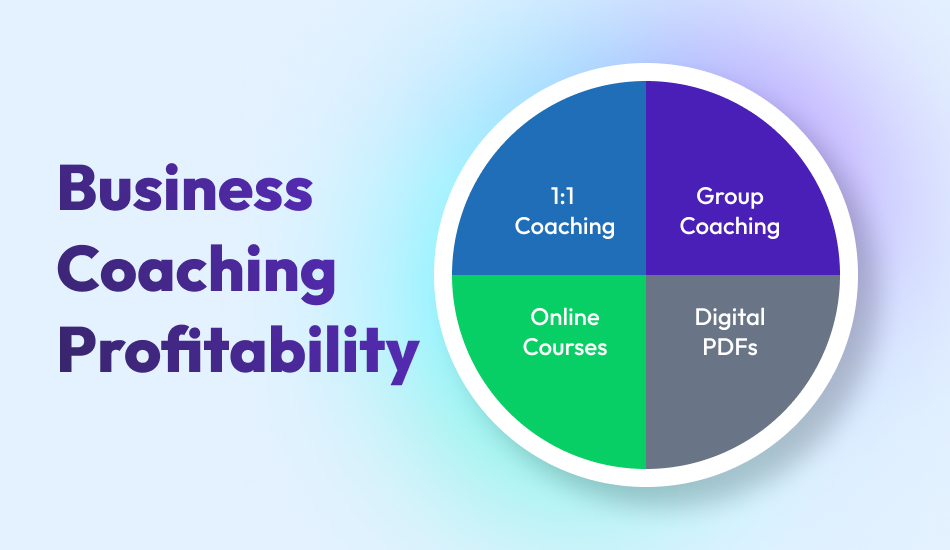
Building a business coaching practice requires more than just knowledge and expertise—it demands a strategic approach to establishing yourself in the market and attracting the right clients. From selecting your niche to creating a scalable coaching program, these steps will set you on the path to long-term success.
One of the key steps in building a profitable business coaching practice is selecting a well-defined niche. Instead of casting a wide net, focusing on a specific area of expertise helps you stand out in a saturated business coaching market and enables you to deliver more personalized and impactful advice.
Whether it’s leadership development, financial management, or another area, specializing in a niche allows you to address specific client challenges with precision.
By narrowing your focus, you can sharpen your messaging and services to resonate with the exact audience you want to attract. This creates a stronger connection with potential clients who are actively seeking solutions in your area of expertise, positioning you as the go-to expert in that niche and letting you charge a premium for your expertise.
For example, you might specialize in helping small business owners scale their operations or focus on coaching entrepreneurs who are launching startups.
When you niche down, your ideal clients feel as though your coaching programs or services were designed specifically for them, addressing their exact challenges and goals. This personalized approach makes it easier to create targeted coaching programs that speak directly to their pain points and offer tailored solutions, ultimately leading to greater client success and measurable business growth.
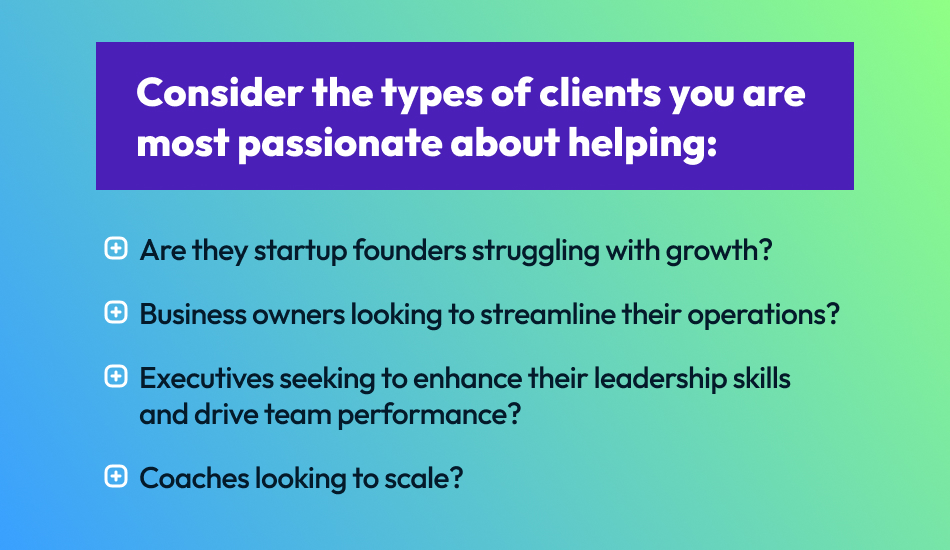
Defining your niche allows you to refine your messaging and attract clients who are a perfect fit for your expertise.
Once you’ve identified your niche, the next step is to design a structured coaching program that delivers real value to your clients. Whether you offer one-on-one coaching or group coaching programs, your business coaching package should provide a clear roadmap to success.
For example, you could create a 12-week program that helps clients develop a strategic plan to increase their revenue, or a six-month package focused on improving leadership skills for business owners.
Offering tiered coaching packages is also an effective way to serve different levels of clients. For instance, you could offer a basic package for newer business owners and a premium package for more established entrepreneurs looking for advanced strategies. This allows you to cater to a wider range of clients while maximizing your earning potential.
Another benefit: your coaching packages pricing can set your business up for recurring revenue, an essential aspect of a stable business.
As a business coach, your expertise is your most valuable asset. While you may not need formal certifications to be successful, continuing to develop your coaching skills will enhance your credibility and ability to serve clients.
Attending industry conferences, taking advanced business courses, and staying updated on the latest business coaching trends can keep you competitive and increase your value in the eyes of potential clients.
Additionally, gathering client testimonials is the most powerful way to build trust and credibility. As you work with more clients, ask them for feedback and showcase their success stories on your website or social media platforms. Positive reviews from satisfied clients highlight your expertise and inspire future clients to envision themselves achieving that same level of success. Seeing real-world examples of others who have transformed their businesses through your coaching can make a significant difference in attracting new clients to your coaching business.
Now that you chose your business niche, it’s time to find clients in that niche.
As a business coach, you need to use targeted strategies to connect with potential clients and demonstrate the value of your coaching services. Let’s dive into how to build a strong online presence, leverage email marketing, and use content marketing to grow your business coaching practice.
In today’s digital world, your online presence is one of the most powerful tools for attracting business coaching clients. Start by creating a professional website that clearly outlines your coaching services, showcases your expertise, and highlights client success stories through testimonials. Make sure your website has an easy way for potential clients to book a discovery call or sign up for a coaching program. Here are some examples of coaching websites to help you get started.
Beyond your website, it’s important to be active on social media platforms where your ideal clients spend their time.
While LinkedIn is especially effective for business coaches working with executives and corporate clients, other platforms can be just as impactful, depending on your target audience. Instagram is great for coaches offering services to other coaches, small business owners, freelancers, or entrepreneurs, for instance. It allows for more personal engagement and creative content sharing.
Regularly posting business tips, industry insights, or case studies across platforms like LinkedIn, Instagram, and even Facebook can help you establish authority and connect with your ideal clients.
Tailor your platform usage based on where your audience is most active—corporate professionals on LinkedIn, freelancers and creatives on Instagram, or local businesses on Facebook.

Email marketing is one of the most cost-effective ways to nurture leads and maintain relationships with potential clients. By building an email list, you can stay connected with people who are interested in your business coaching services. Offering a valuable piece of free content (a “lead magnet”) such as a free eBook, checklist, or webinar, helps encourage website visitors to subscribe to your emails.
Once you have their contact information, send them a series of emails that provide actionable business tips, share success stories, and invite them to book a consultation.
The key is to consistently provide value while gently guiding your leads toward signing up for your coaching program. Include clear calls-to-action in every email, whether it’s to schedule a free strategy session or join one of your group coaching programs.
As a business coach, content marketing can position you as an expert and attract more coaching clients. Regularly publishing blog posts, podcasts, and webinars is a great way to demonstrate your expertise and provide value to business owners who are looking for guidance.
For example, you could create a blog post on “How to 10X Your Revenue” or host a webinar on “Effective Leadership Strategies for Growing Businesses.” Sharing this content on your social media platforms and through your email list will drive engagement and encourage potential clients to take action.
Looking into partnerships where you can guest blog or be a guest on someone else’s podcast is another great way to expand your reach and achieve more referrals.
By consistently producing high-quality content, you’ll build trust with your audience, which can ultimately lead to more clients for your business coaching practice.
To build a sustainable and profitable business coaching practice, relying on just one source of income isn’t enough. Diversifying your income streams by offering additional products and services allows you to maximize your revenue while meeting the various needs of your clients.
From online courses to group coaching programs, these strategies will help you create passive income and scale your business. Let’s explore how to generate multiple income streams as a business coach.
One of the best ways to create passive income is by developing and selling online courses. As a business coach, you have valuable knowledge that can help business owners and entrepreneurs overcome challenges and grow their businesses. By packaging this expertise into an online course, you can reach a much larger audience than with one-on-one coaching. And your customers can learn at their own pace.
If you need help in how to create an online course, some ideas could be creating a course on “Scaling a Business to Six Figures.” Once the course is created, you can sell it repeatedly without having to invest more time in delivering the content.
This allows you to continue earning revenue while focusing on other aspects of your coaching practice.
In addition to online courses, offering digital products such as templates, workbooks, and guides can provide another revenue stream for your business coaching practice. These products can offer clients practical tools that complement your coaching sessions. For example, you could sell a “Business Planning Template” for small business owners or a “Sales Strategy Workbook” for startups looking to grow.
The benefit of digital products is that, just like online courses, they are scalable. Once created, you can sell them on autopilot. This makes them an excellent way to add passive income to your business.
Group coaching programs are another highly effective way to scale your business coaching practice. Unlike one-on-one coaching, group coaching allows you to serve multiple clients at once, increasing your impact and your income without a significant increase in time spent. These programs can be structured around specific business goals, such as “Growing Your Business from Startup to Scale” or “How to Run a Business Organically.”

Not only do group coaching programs allow you to reach more people, but they also create a collaborative environment where participants can learn from each other’s experiences.
This adds additional value to your program and helps build a sense of community among your clients. Pricing your group coaching competitively makes it an attractive option for business owners who are looking for more affordable coaching services but still want expert guidance.
Transforming your business coaching practice from a part-time endeavor into a full-time, sustainable career requires a well-thought-out strategy.
To ensure long-term success, you need to scale your operations, manage your time effectively, and create a reliable income stream that supports your transition to full-time business coaching. Here are some tips to take your business to the next level.
Automation is one of the most powerful tools for scaling a business coaching practice. By automating routine tasks such as client onboarding, scheduling coaching sessions, and sending follow-up emails, you can save time and focus on delivering value to your clients.
Also, automating lead generation and email marketing allows you to consistently engage with potential clients and guide them through your sales funnel, turning them into paying customers.
You can create automated email sequences that nurture leads, promote your coaching programs, and invite subscribers to book discovery calls. This consistent flow of communication can help increase client acquisition and retention, all while freeing up your time.
As your business coaching practice grows, managing your time effectively becomes even more important. Start by setting boundaries around your schedule. Dedicate specific time blocks for coaching sessions, content creation, and client acquisition, while also ensuring you have time for personal development and rest.
If you find yourself bogged down with administrative tasks, consider outsourcing certain aspects of your business, such as social media management or bookkeeping. This allows you to focus on the higher-level activities that drive growth in your coaching practice, such as developing coaching programs and improving client relationships.
For many business coaches, the goal is to transition from part-time to full-time coaching. To make this leap, it’s helpful to have consistent income streams in place, whether through one-on-one coaching, group coaching programs, or digital products.
One effective way to ensure steady income is by securing a few clients on a monthly retainer package. This model provides recurring revenue and makes the transition to full-time coaching smoother since you’ll have consistent income each month.
Establish a financial plan that outlines how much revenue you need to generate to support a full-time lifestyle, and track your progress toward that goal. Before making the shift, consider setting milestones for client acquisition and revenue growth.
For instance, you may decide to move into full-time coaching once you’ve secured a certain number of retainer clients or built enough passive income from your online courses. With a solid plan and consistent income in place, you’ll have the confidence and stability to take your business to the next level.

Building a successful business coaching practice takes time, effort, and a commitment to continuous growth. To thrive in the business coaching industry, you need to focus on delivering value to your clients, staying consistent with your marketing efforts, and investing in your own professional development.
By consistently delivering value, staying committed to your marketing strategies, and investing in your own growth, you can build a profitable business coaching practice that thrives in the long term. These strategies will not only help you attract more clients but also ensure that your own business continues to grow and evolve in the competitive business coaching industry.
Want to see how easy it is to grow your coaching business with Kartra? Get started today and experience it for yourself.
Success often takes us down unexpected paths. For Dielle Charon, MSW, that journey began as a social worker before evolving into a remarkable, multimillion-dollar career. As a certified life coach and a 7-figure sales expert, Dielle empowers women of color (WOC) to achieve financial independence. She leads two sales programs—Five Figure Freedom and Six Figure Liberation—which have served over 300 WOC. She also hosts the Woman Of Color Sales Show Podcast, which boasts over 150,000 downloads. Her journey shows how determination, belief in oneself, and how the right tools can turn dreams into reality.

Before the popular podcast and multimillion-dollar success, Dielle’s story was one of struggle and perseverance. It all began in a place many know well—working a nine-to-five job that left her exhausted and unfulfilled. As a social worker, Dielle earned just $2,500 a month, barely enough to cover her rent.
Her daily commute took three hours round trip on a bus, leaving her drained and with little time to spend with her fiancé. “I was just thinking to myself, I can’t do this,” she says. “I realized within the third day of me being at this job that I can’t stay here.”
Instead of looking for another job, Dielle made a bold decision—she would build a life that offered the freedom she craved. She launched her first brand, “The Busy Girls Club,” where she coached women on managing their busy lives. This was the start of her entrepreneurial journey.
Like many new entrepreneurs, Dielle quickly discovered that building an online business came with challenges. “I didn’t have any tech experience or business experience,” she admits. The learning curve was steep, and she felt overwhelmed by the complexities of setting up sales funnels, creating online courses, and building marketing strategies.
While using other marketing platforms, one of her earliest struggles was figuring out how to connect her online course to an email nurture series. “That thing took me days and days and days to do, and it was so frustrating and overwhelming,” she recalled. “I remember thinking, if this is what it takes to run an online business, then I’m screwed.”
On top of the technical challenges, Dielle faced confidence issues. Comparing herself to other entrepreneurs who seemed to have it all together was tough. But over time, she realized that her audience was there for her—authentic and relatable, not just a polished image.
As Dielle’s business grew, so did the demands on her time and resources. She needed a solution that could simplify her operations and allow her to focus on what she loved most—coaching and inspiring others. That’s when she discovered Kartra, and everything changed.
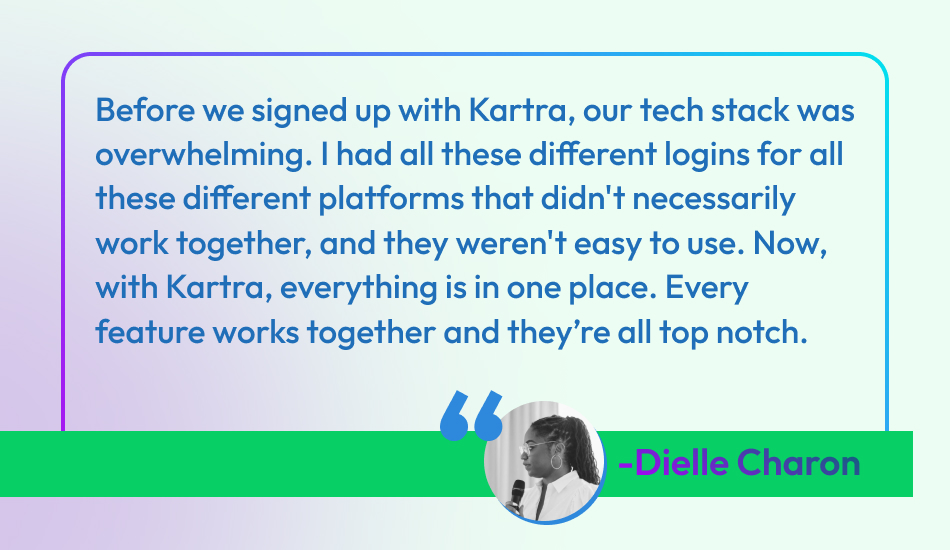
With Kartra at the core of her business, Dielle’s success took off. She went from earning $40,000 in 2019 to $300,000 in 2020, and then on to seven-figure revenues in the following years! Kartra made it possible for her to manage her new campaign launches, build beautiful courses, and connect with her audience—all from a single platform.
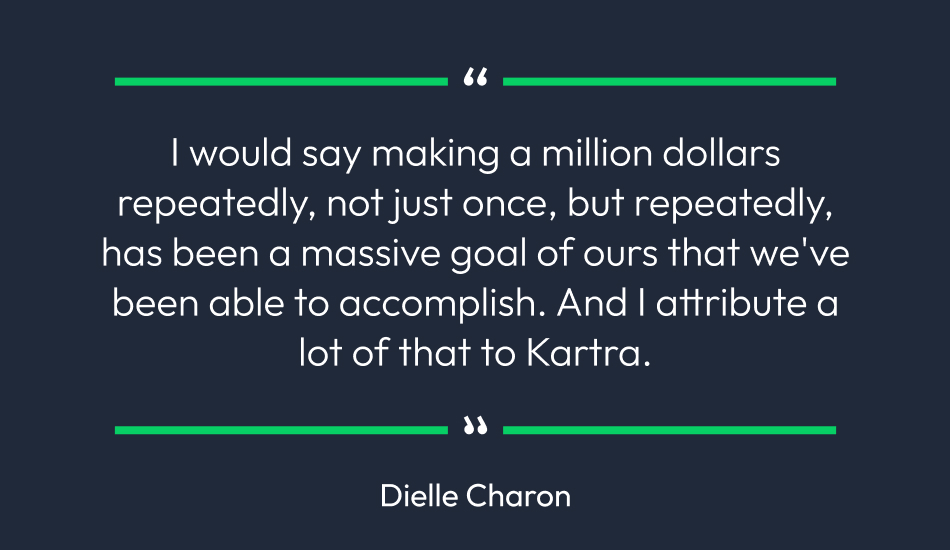
One of the strategies that Dielle credits for her success is her “Disney World” launch strategy. “Before the doors even open, you want your launches to feel so exciting. You want people to line up at the gate waiting to work with you,” she explains. Supported by Kartra’s robust tools, this strategy helped her go from $10K launches to $500K launches.
Even with a relatively small audience—just 3,000 email subscribers—Dielle has been able to achieve remarkable results. She says that Kartra’s reliable email deliverability and user-friendly course platform has been a major help.

For Dielle, Kartra wasn’t just another software; it was the game-changer that allowed her to scale her business and achieve her financial goals. Here are the five most valuable ways Kartra helped Dielle grow her business:
1. All-in-One Platform: Kartra eliminated the need for multiple software tools, consolidating everything from email marketing to course creation in one place, saving time and reducing complexity.
2. Reliable Email Deliverability: Kartra’s email platform ensured that every message reached her audience, which was crucial for a business with a smaller subscriber base.
3. High-Quality Course Platform: Kartra’s course platform is not only easy to use but also beautifully designed, offering Dielle’s clients a seamless and engaging experience.
4. Robust Funnel and Launch Tools: Kartra provided the infrastructure needed for Dielle to execute highly successful launches, allowing her to go from $10K to $500K launches.
5. User-Friendly Interface: Kartra’s intuitive design made it easy for Dielle to set up and manage her business operations without needing extensive technical knowledge.
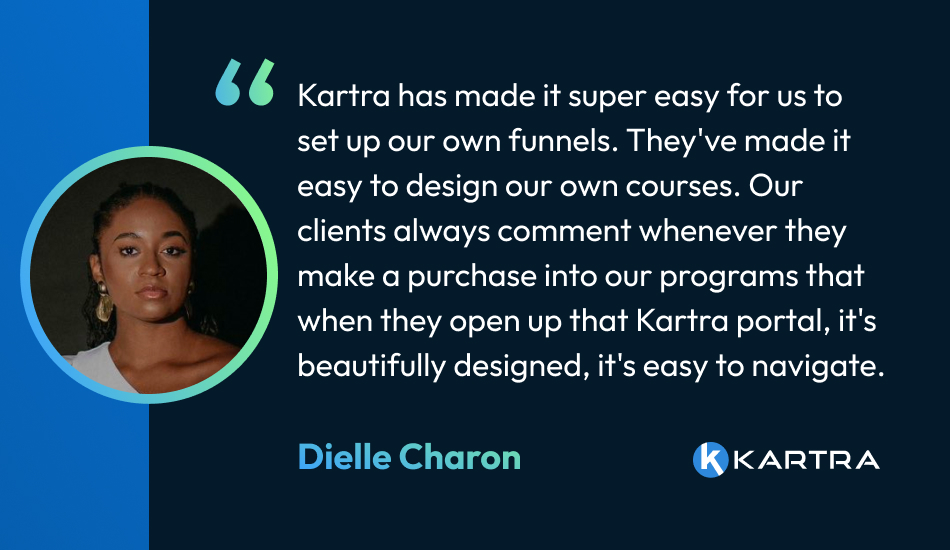
Dielle’s journey proves that with the right tools and mindset, anyone can build a successful business. Her advice? “Go with the punches. If the industry or the market is telling you something, test it out.” She encourages other entrepreneurs to embrace the creativity and freedom that comes with the entrepreneurial journey and to be willing to try new things.
Looking ahead, Dielle is excited about exploring new opportunities in her business. She plans to double down on content creation, grow her email list, and experiment with lower-ticket offers. With Kartra by her side, she’s ready to continue scaling her business and reaching even greater heights.
Dielle Charon’s story is more than just a success story—it’s a blueprint for anyone looking to build a business that offers both financial freedom and personal fulfillment. If you’re ready to streamline your operations and take your business to the next level, Kartra is here to help.
Get started with Kartra today and discover how Kartra can help you achieve your business goals, just like it did for Dielle.
Want to build a personal brand but not sure how or where to start? Here at Kartra, we’ve seen thousands of coaches, creators, and experts use our all-in-one platform to grow their online brands.
In this guide, we’ll look at 25 successful personal brands to see what’s working for them and what’s worth incorporating in your own personal brand. Pay particular attention to their personal brand statements and the consistent message these individuals share in everything they do.
As you look through these personal brand examples, notice that while the people behind these brands have a wide variety of skills, interests, personality traits, and experiences — they’ve each found a specific problem that they solve for a specific audience… and they built their personal brand on that message.
Your message will need to be just as clear — and just as consistent — for your personal brand to stand out.
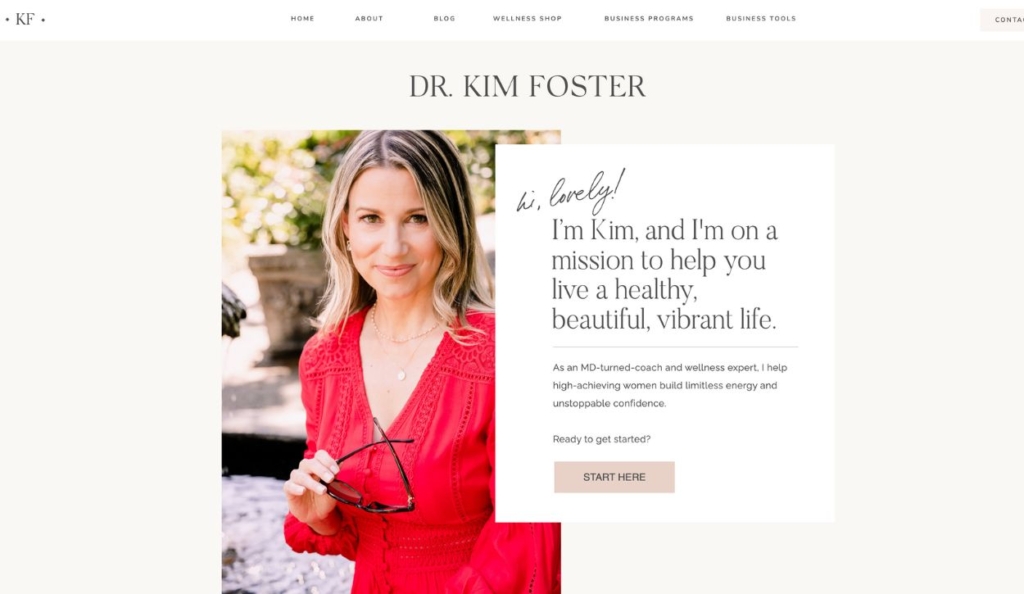
Dr. Kim Foster’s website homepage
Dr. Kim Foster is a physician turned health coach who advocates holistic wellness for high-achieving women and helps health professionals like her build successful wellness coaching businesses.
Personal brand statement
What stands out
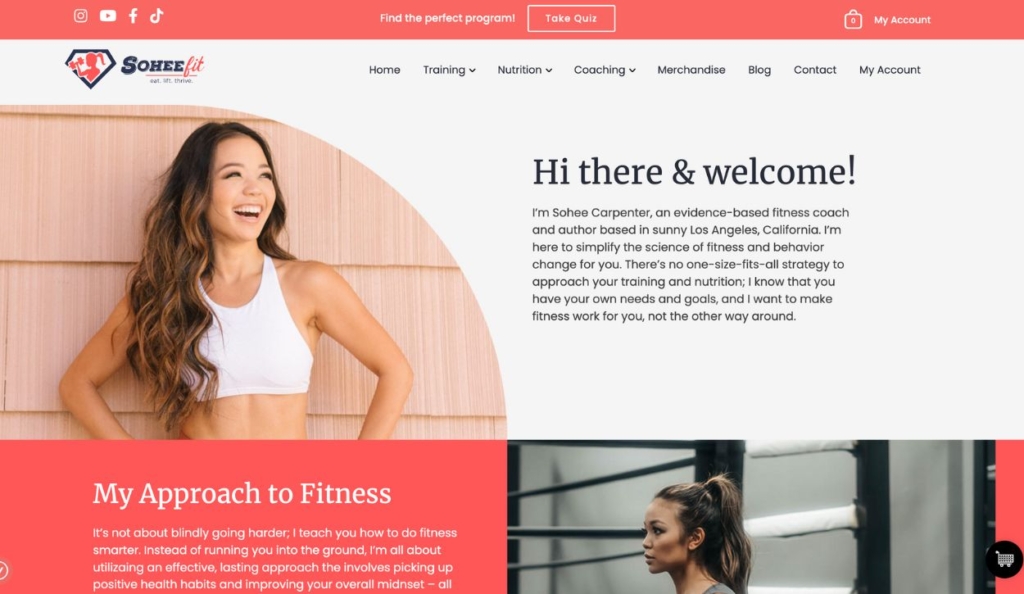
Sohee Carpenter’s website about page
Sohee Carpenter is a fitness coach and content creator who specializes in evidence-based approaches to training and nutrition, empowering clients to build sustainable health and fitness habits.
Personal brand statement
What stands out
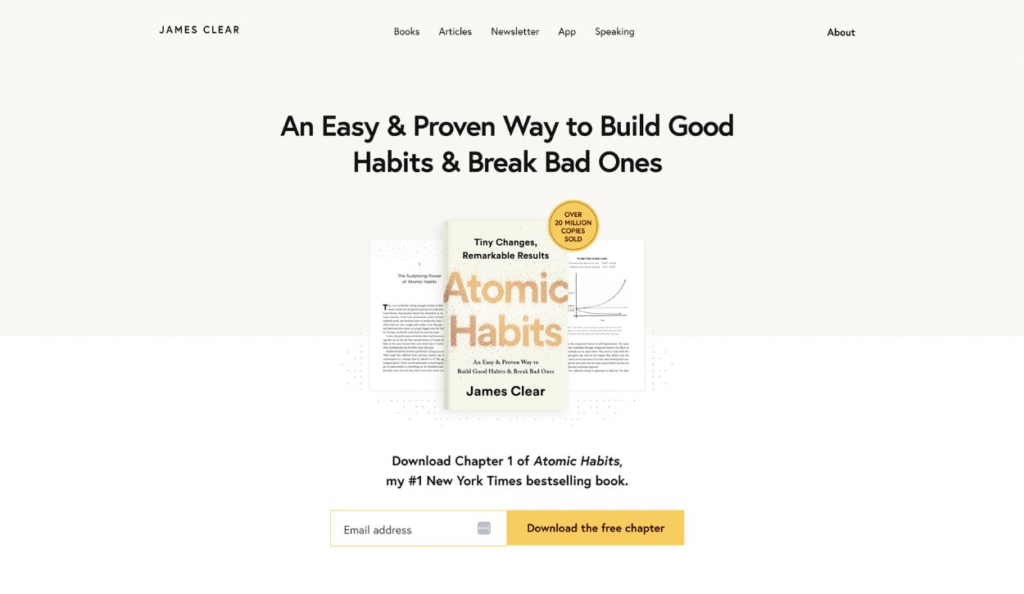
James Clear’s website homepage
James Clear is a best-selling author and speaker known for his expertise in habits and decision-making — helping people achieve better results through small, incremental changes.
Personal brand statement
What stands out
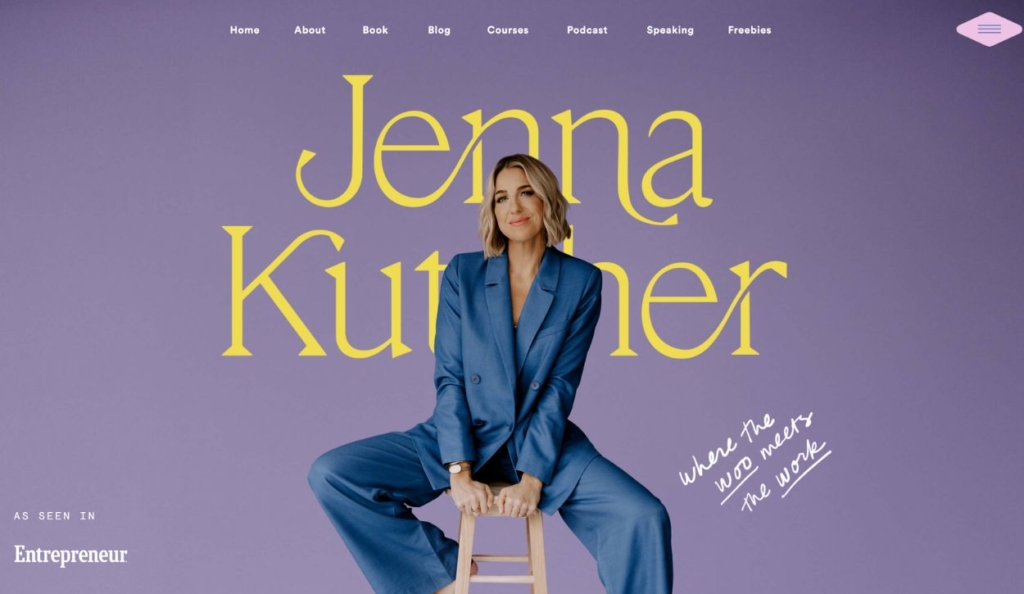
Jenna Kutcher’s website homepage
Jenna Kutcher is a digital marketer and coach who helps entrepreneurs build profitable businesses while maintaining a balanced lifestyle.
Personal brand statement
What stands out

Louise Henry’s website about page
Louise Henry is an online business strategist and course creator who shows entrepreneurs how to simplify and automate their businesses using digital tools.
Personal brand statement
What stands out
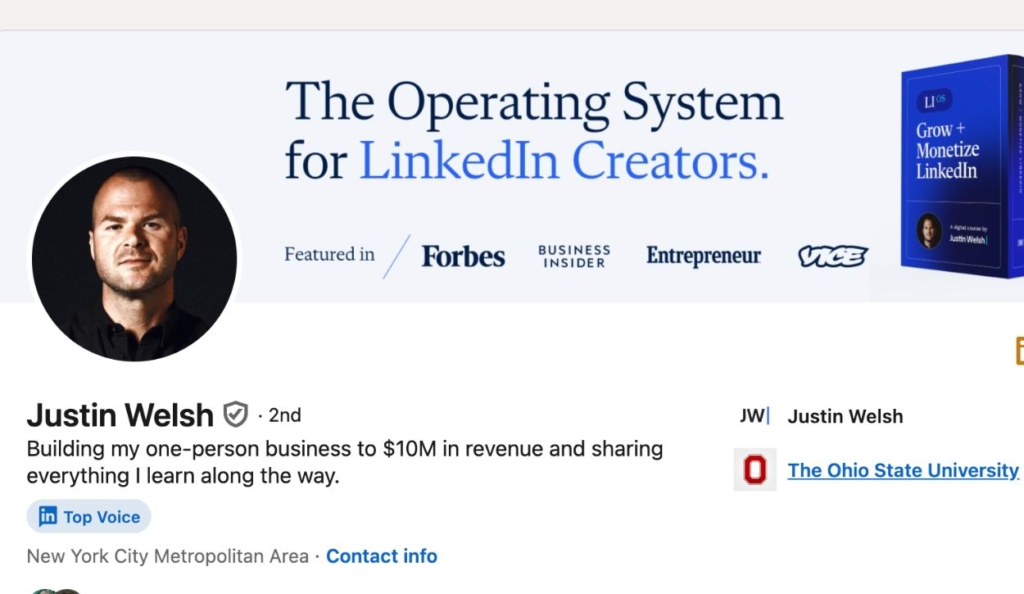
Justin Welsh’s LinkedIn profile
Justin Welsh is a solopreneur and content creator who helps other solopreneurs grow their online businesses by sharing what he’s learned from his own successful journey.
Personal brand statement
What stands out
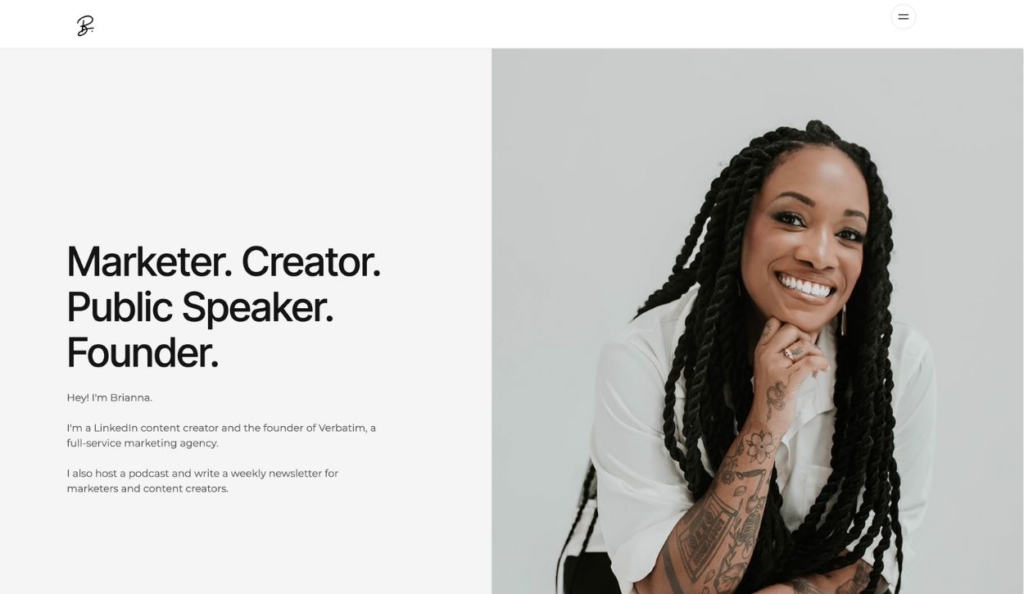
Brianna Doe’s website homepage
Brianna Doe is the founder and CEO of a digital marketing agency for startups and small businesses. She’s also a podcast host and content creator who shares insights from her career journey and industry expertise.
Personal brand statement
What stands out

Dr. Stephanie Ridgway’s website homepage
Dr. Stephanie Ridgway is a physical therapist who helps her clients improve their strength and mobility to overcome injuries.
Personal brand statement
What stands out
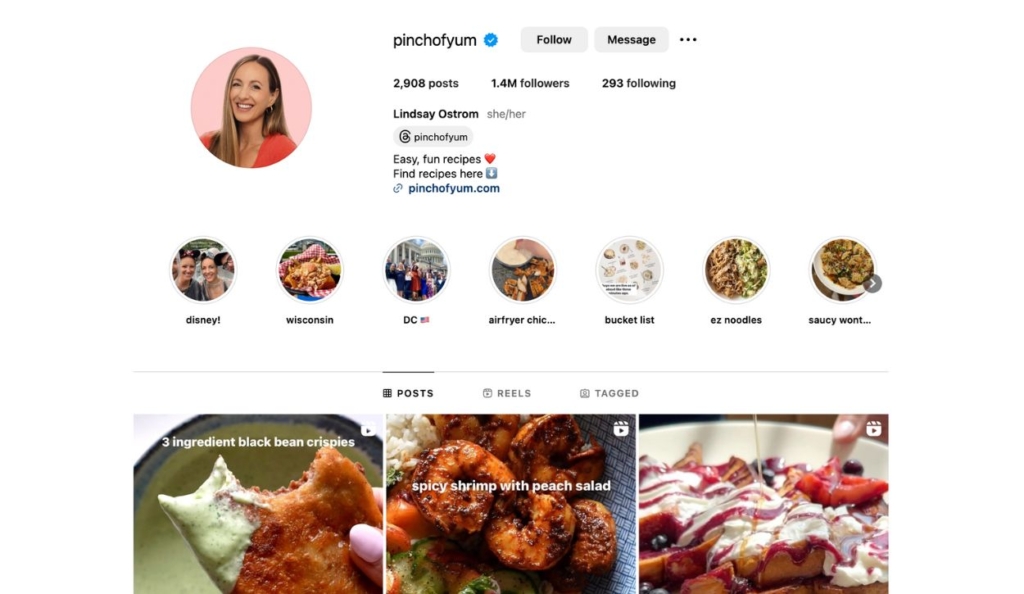
Lindsay Ostrom’s instagram account for Pinch of Yum
Lindsay Ostrom is the author and cook behind one of the internet’s most successful food blogs, Pinch of Yum.
Personal brand statement
What stands out
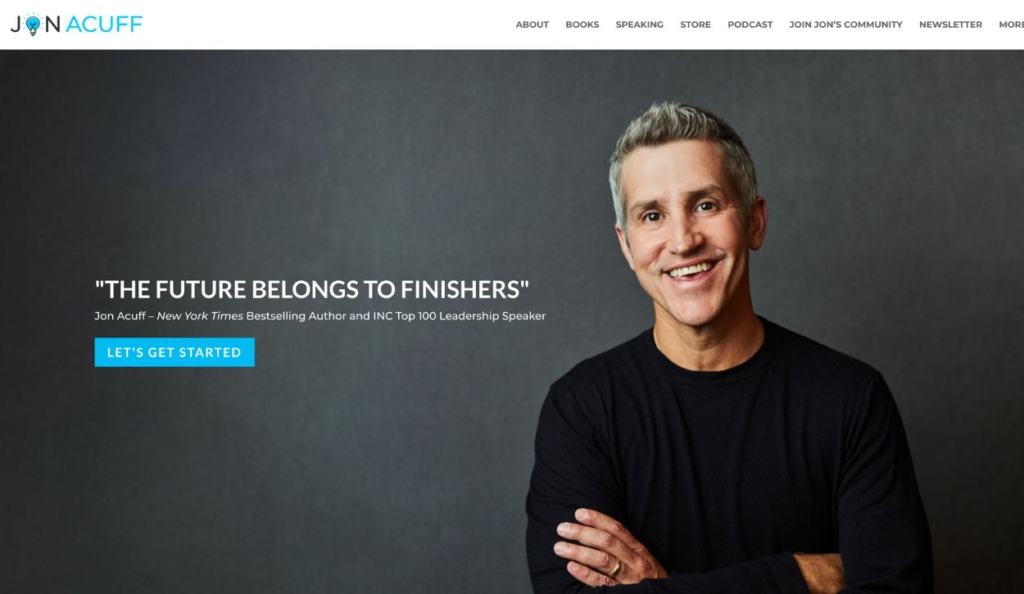
Jon Acuff’s website homepage
Jon Acuff is a motivational speaker and author who inspires individuals to achieve their goals by providing practical advice on overcoming challenges and taking action.
Personal brand statement
What stands out
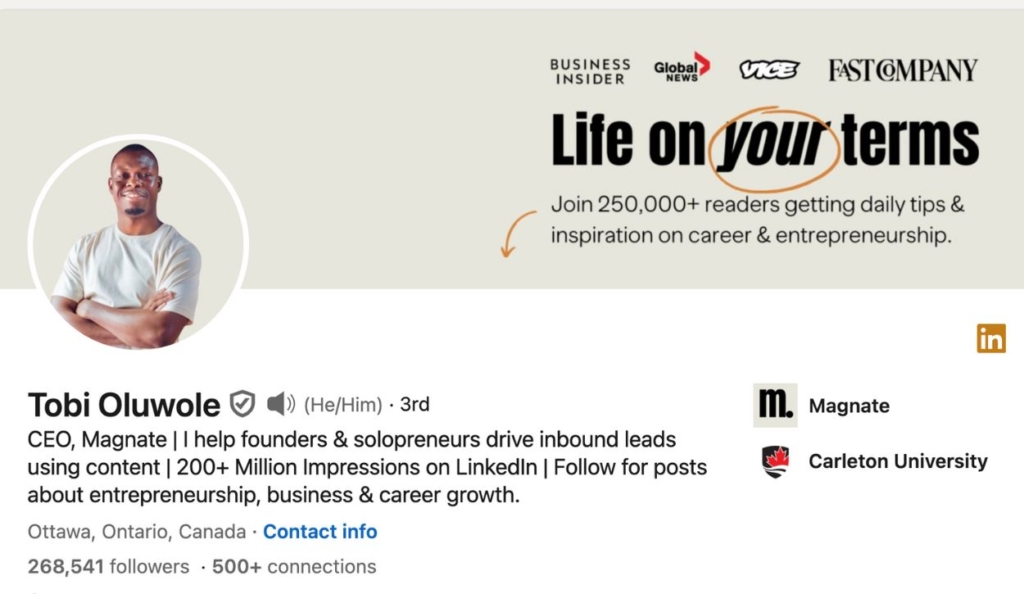
Personal Brand Example
Tobi Oluwole is an entrepreneur, content creator, and coach who helps people build successful careers and businesses through content marketing, particularly on LinkedIn.
Personal brand statement
What stands out
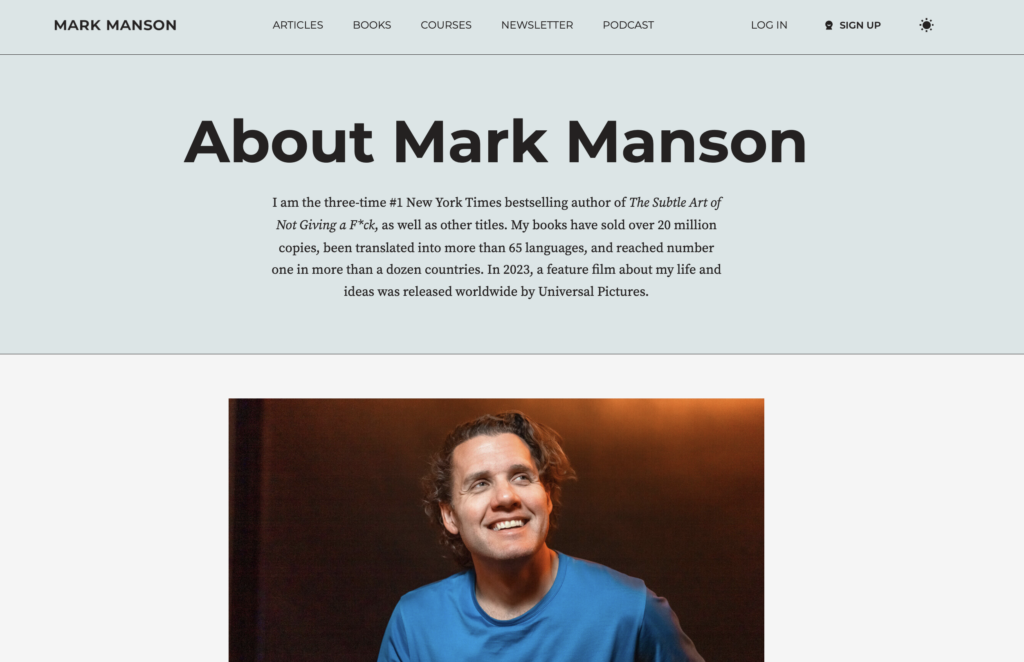
Mark Manson’s personal website
Mark Manson, three-time #1 New York Times bestselling author of The Subtle Art of Not Giving a F*ck, is known for his no-nonsense approach to self-help and personal development. He tackles life’s big questions with a blend of humor, research, and practical advice.
Personal brand statement
What stands out
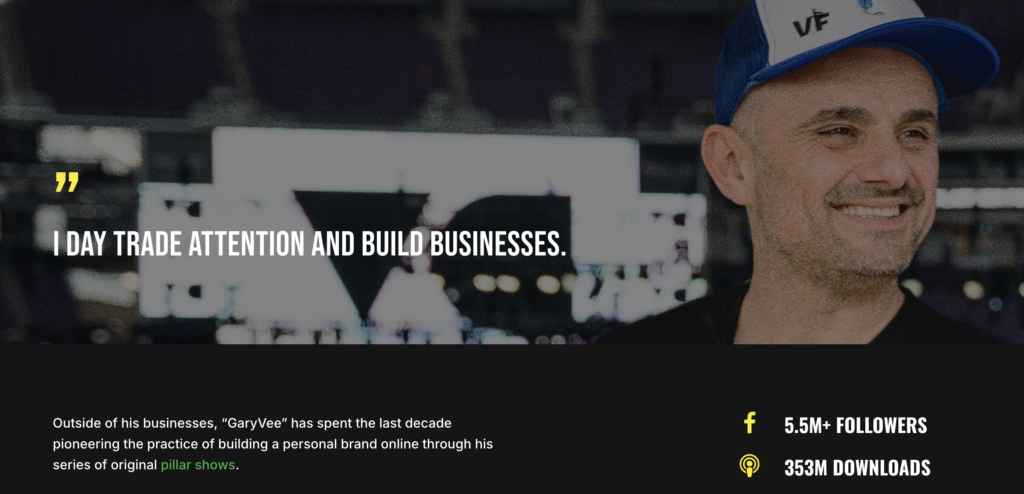
Gary Vaynerchuck’s website
Gary Vaynerchuk, also known as “Gary Vee,” is a renowned entrepreneur, social media expert, and motivational speaker who inspires people to pursue their passions and build successful businesses.
Personal brand statement
What stands out
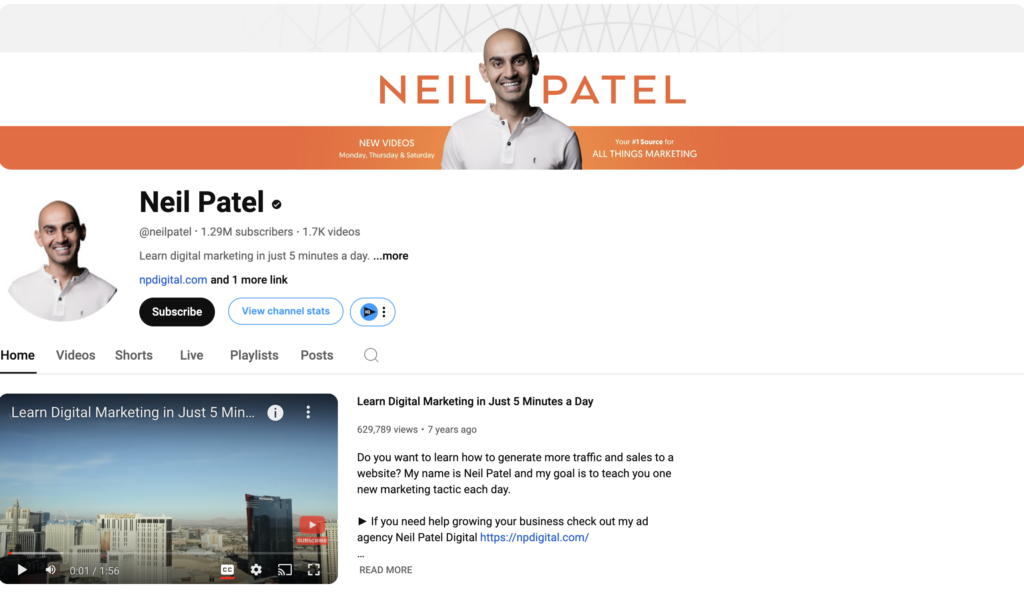
Neil Patel’s YouTube Channel
Neil Patel is a renowned digital marketing expert, entrepreneur, and author who helps businesses grow their online presence and increase their revenue through effective marketing strategies.
Personal brand statement
What stands out
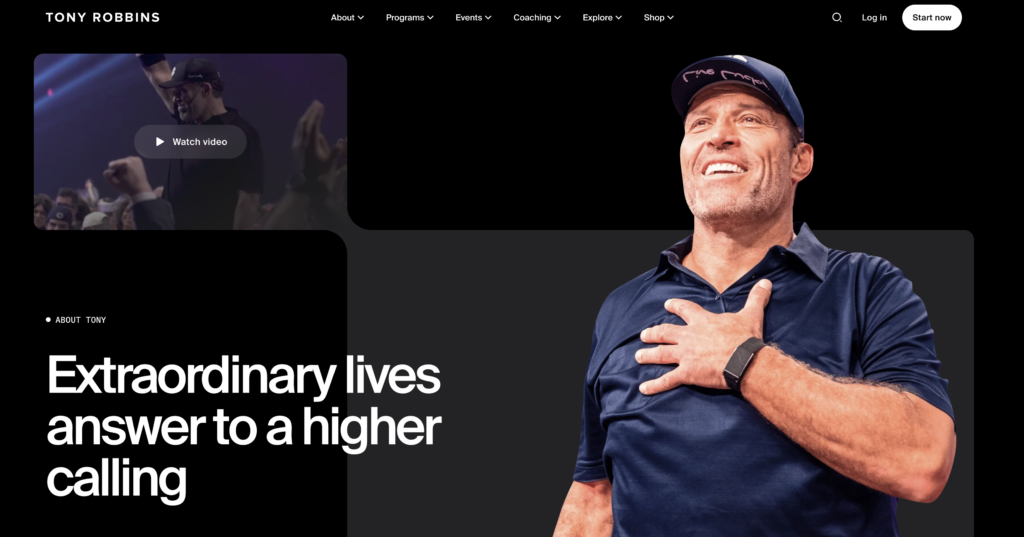
Tony Robbins’ Website
Tony Robbins is a world-renowned life and business strategist, author, and philanthropist who empowers people to achieve personal and professional breakthroughs.
Personal brand statement
What stands out

Marie Forleo’s Website
Marie Forleo is a life coach, course creator, motivational speaker, and author who helps people create businesses and lives they love. She’s known for her upbeat personality and practical advice.
Personal brand statement
What stands out
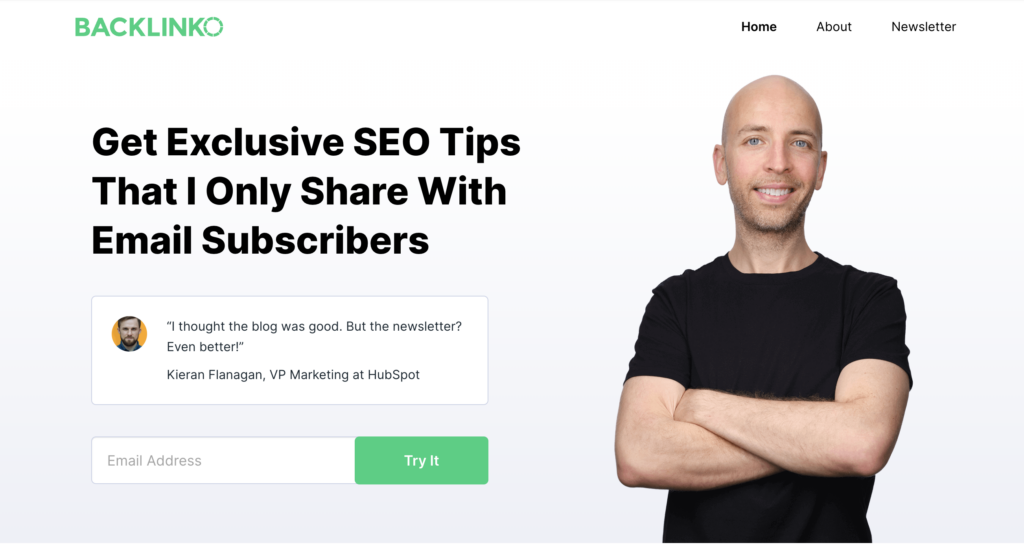
Brian Dean’s “Backlinko” website
Brian Dean is an SEO expert and the founder of Backlinko and Exploding Topics. He’s known for his data-backed content marketing strategies and was one of the first influencers in the search engine marketing space.
Personal brand statement
What stands out

Sara Blakely’s Forbes Profile
Sara Blakely is the founder of Spanx and a self-made billionaire who inspires entrepreneurs, particularly women, to pursue their business ideas and overcome obstacles.
Personal brand statement
What stands out
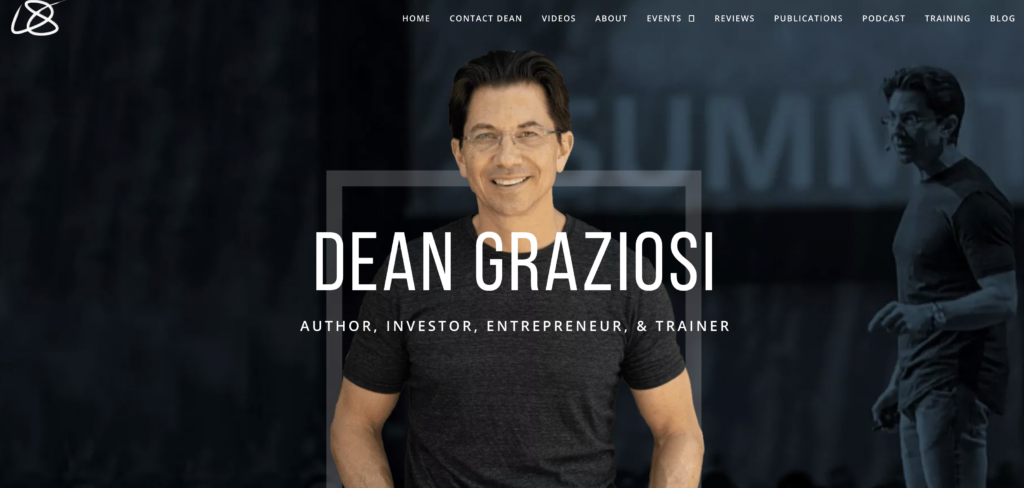
Dean Graziosi’s Website
Dean Graziosi is a multiple New York Times best-selling author, entrepreneur, and investor who teaches people how to create wealth through real estate and business.
Personal brand statement
What stands out
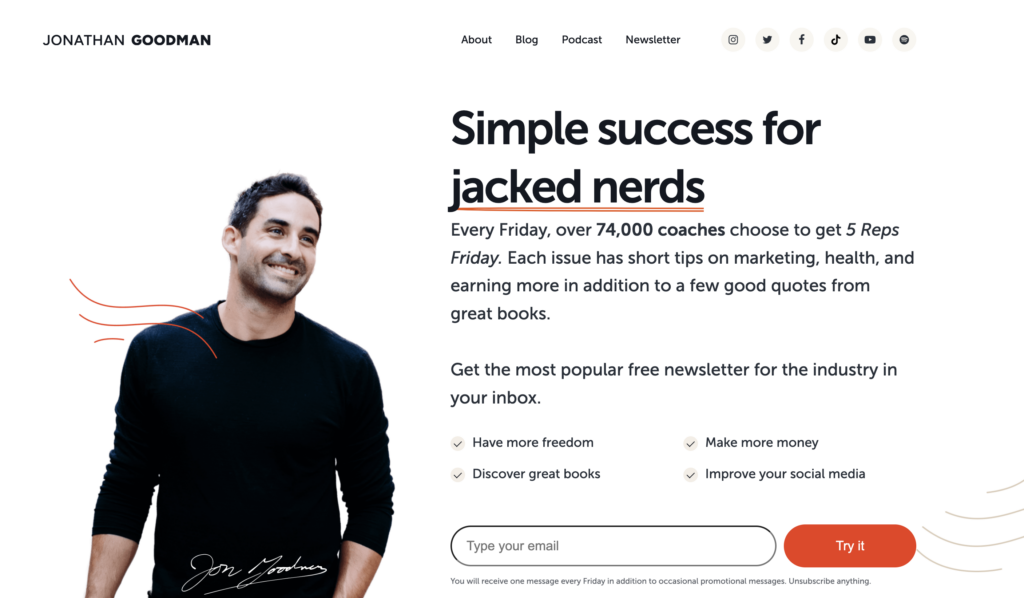
The PTDC Website
Jon Goodman is the founder of the Personal Trainer Development Center (PTDC), Online Trainer Academy, and QuickCoach and author of numerous books. He’s known for helping fitness professionals build successful online businesses.
Personal brand statement
What stands out
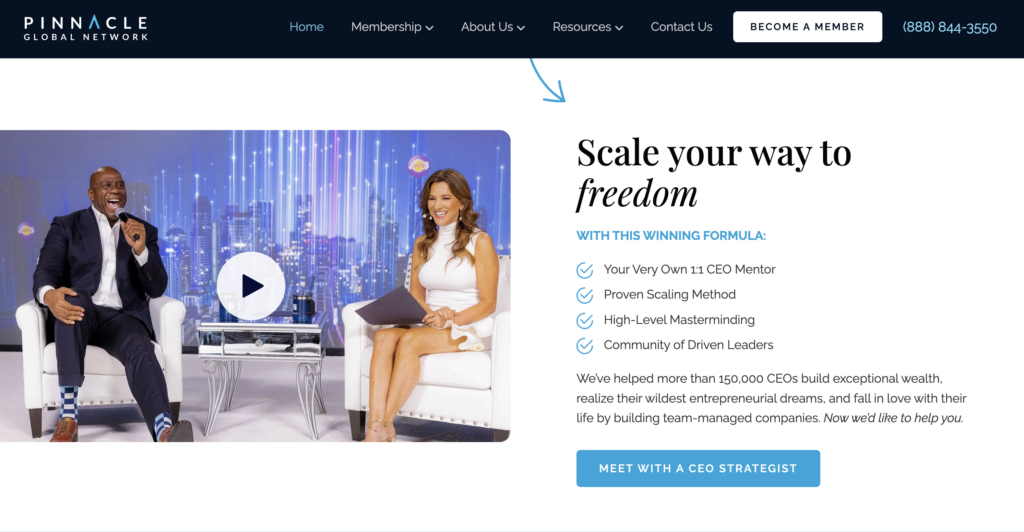
Pinnacle Global Network’s Website
Allison Maslan is a respected business mentor who teaches business owners how to scale their companies while maintaining a high quality of life.
Personal brand statement
What stands out

Simon Sinek’s Personal Website
Simon Sinek is a globally recognized leadership expert, bestselling author, and inspirational speaker who helps organizations and individuals discover and articulate their purpose.
Personal brand statement
What stands out

Lori Greiner’s Personal Website
Lori Greiner is an inventor, entrepreneur, and television personality known for her role as an investor on the hit show Shark Tank. She’s often called the “Queen of QVC” for her success in selling products on the QVC shopping network.
Personal brand statement
What stands out
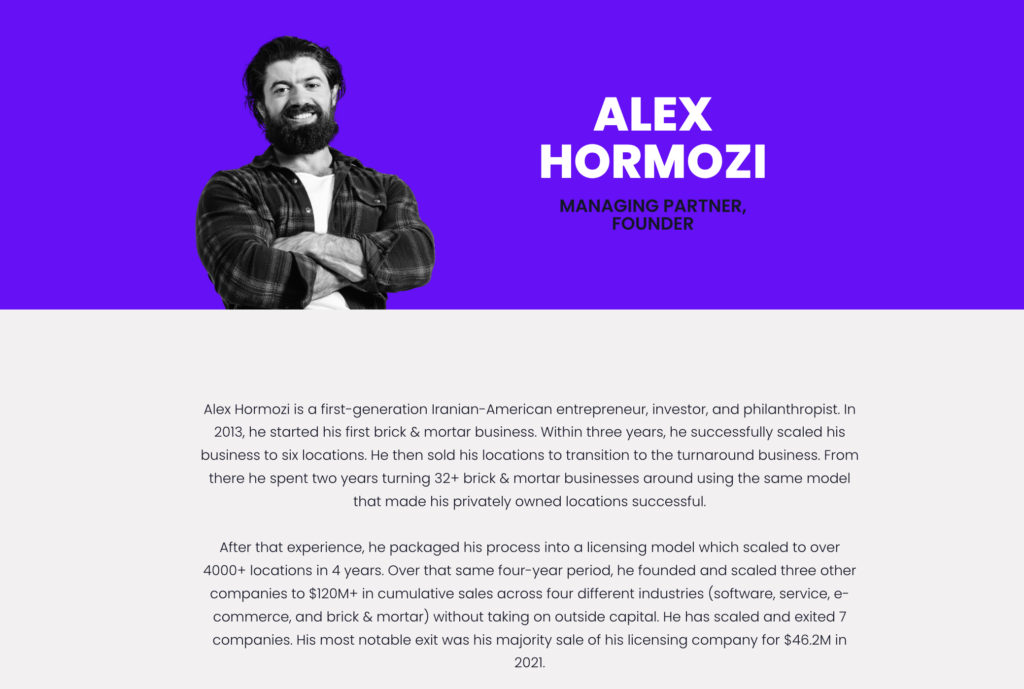
Alex Hormozi’s Bio on Acquisition.com
Alex Hormozi is an entrepreneur and investor best known for his ability to scale businesses rapidly and his no-holds-barred approach to marketing and sales advice.
Personal brand statement
What stands out
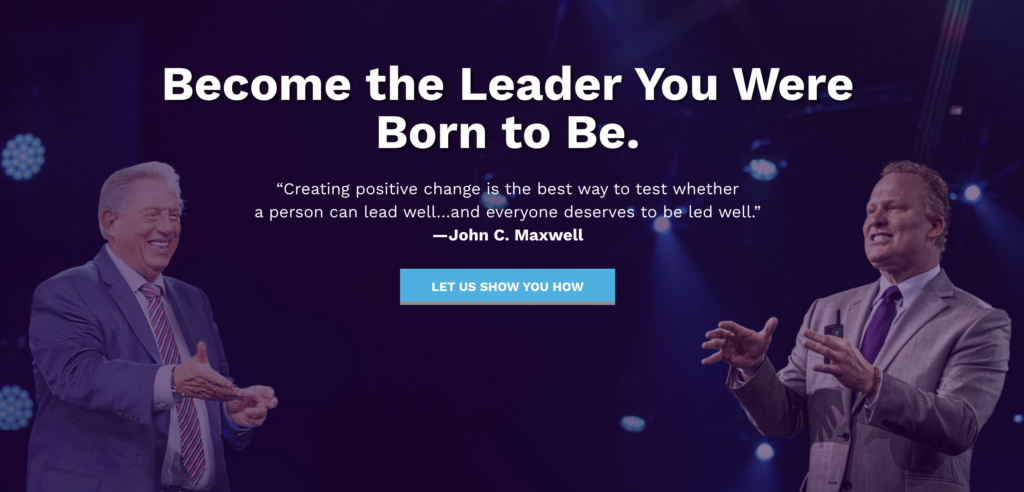
Maxwell Leadership Business Website
John C. Maxwell is a renowned leadership expert, speaker, and author who has written over 100 books, primarily focusing on leadership and effective communication.
Personal brand statement
What stands out
These personal brand statement examples look very different from each other, but each successful entrepreneur on the list has effectively distinguished themselves in their market.
Here’s one strategy they all have in common…
Each of these personal brands presents a clear and consistent message that resonates with their potential clients and sets them apart from their competitors. From their strong personal brand statements to the topics they cover on social media platforms, it’s easy to see the unique value they provide to their followers.
Get started by crafting a personal brand statement (also called a value proposition or elevator pitch). This sentence or two captures exactly who you are, what you do, and for whom.
I help [target audience] [goal-based verb statement] by [verb statement]
An effective personal brand statement will be tailored to your message and your audience. Use this template to get started, and make it your own – then put consistent effort into sharing that message across all your marketing channels.
Use a platform like Kartra to set up email sequences, sales funnels, online courses, and other automated systems that you’ll need to get your message out there and keep your audience engaged.
Kartra’s all in one platform makes it simple to set up automated systems that bring in clients and make sales on autopilot — so you can focus on creating valuable content and innovating new ideas that move your business forward.
A well-crafted landing page is more than just a single web page; it’s a powerful marketing tool that can boost your sales and reduce acquisition costs. While marketing platforms like Kartra will help you do it quickly, diving in without a clear strategy can lead to missed opportunities.
To truly maximize the potential of your landing page, it’s essential to follow best practices that combine effective design elements with strategic messaging. These practices not only help create an attractive and functional page, but also ensure a seamless user experience that aligns with your brand. Let’s explore these proven strategies to help you design a landing page that looks great and drives real results.
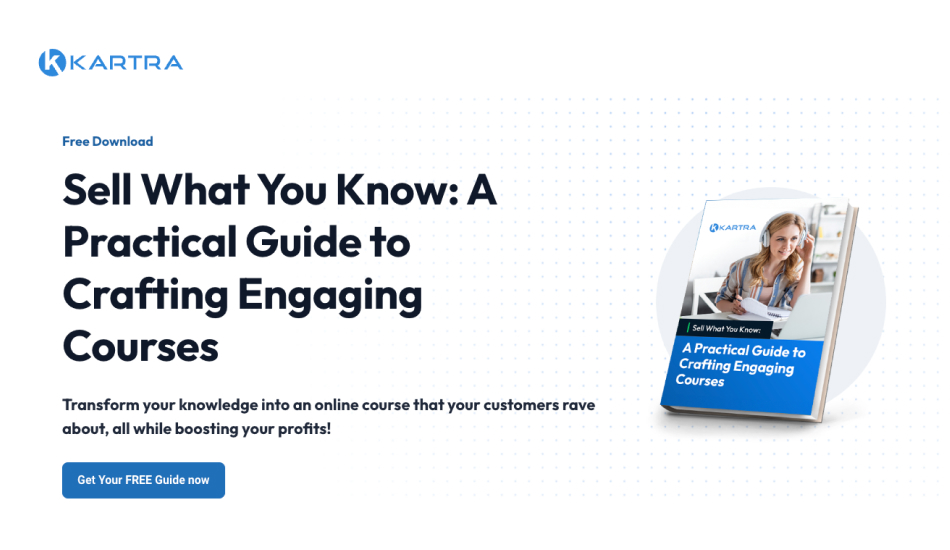
Landing pages are specialized web pages designed with a single, focused objective. Unlike regular web pages, which often serve multiple purposes and link to various sections of a site, landing pages are created to guide visitors toward a specific action.
Landing pages are a vital component of digital marketing strategies. They offer a focused, effective way to drive conversions, capture leads, and track campaign performance. Whether it’s capturing email leads, promoting a product, or encouraging webinar sign-ups, landing pages streamline the user experience to maximize conversions.
These pages typically feature a clear headline, compelling copy, and a prominent call-to-action (CTA) that directs visitors towards the desired outcome. By eliminating distractions and focusing on one goal, landing pages help businesses achieve their marketing objectives more effectively and efficiently.
By understanding and leveraging the power of landing pages, businesses can significantly boost their marketing efforts and achieve their goals.
Now that we understand what landing pages are and the purpose they serve, let’s discuss how to build them.
Creating an effective landing page begins with a clear understanding of its purpose. This foundational step shapes every aspect of your design and copywriting, ensuring your page effectively engages visitors and drives desired actions. Let’s explore how to define your landing page’s purpose, then move through the other necessary elements for success.
Every landing page should have a singular, well-defined goal. This goal dictates what action you want your visitors to take.
Here are some common objectives and how they influence your page:
Once we’ve identified our goal, we can transition into crafting copy and messaging.

The foundation of a successful landing page is a clear, compelling message. Your message should instantly convey who you are, what you offer, and why it matters to the visitor. This all starts with understanding your audience.
Understanding your audience is the cornerstone of creating an effective landing page. When you know who you’re speaking to, you can tailor your message and design, so they resonate with your audience’s specific needs, desires, and pain points. You should identify what their pain points are, and what solutions they are seeking. Tailoring your landing page to address these questions will set the foundation for a compelling and relevant experience. This targeted approach increases the likelihood of engagement and conversion because your landing page will feel personalized.
Now let’s get into the copy!
Your landing page needs to make a great impression quickly. Your headline is the first thing visitors see and sets the tone for the rest of the page. Make it compelling and benefit-driven. You’ll want to use large, bold fonts and contrasting colors to ensure it stands out. Instead of focusing on features, emphasize how your offer can make a positive impact. Your headline should clearly state the benefit of your offer. Think of it as the hook that draws your visitors in.
Tip: Use action-oriented language that speaks directly to the visitor’s needs and desires. For example, instead of “Sign Up for Our Newsletter,” try “Unlock Exclusive Tips to Transform Your Fitness Routine Today!”
From there you’ll move into the body of your landing page. When creating this copy, you’ll want to focus on benefits–not features. By doing so, you’ll demonstrate that your offer solves problems, addresses the audience’s pain points and offers solutions for your reader. Use clear and concise language, avoid jargon, and incorporate social proof (like testimonials and reviews) to build trust. Bullet points can enhance readability and highlight key benefits effectively.
The last section in your copywriting is the call to action (CTA).
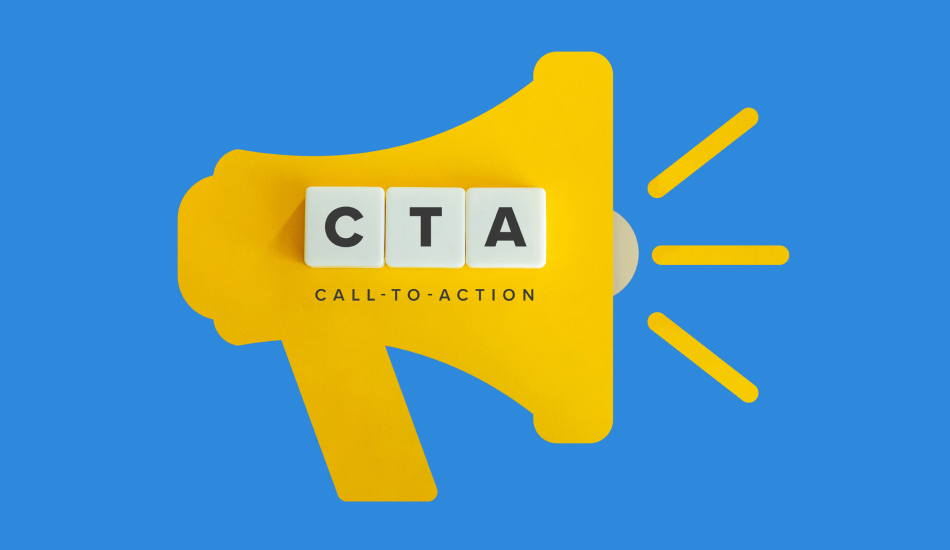
Your CTA is the action you want visitors to take, whether it’s signing up for a newsletter or making a purchase. Your CTA should stand out on the page in both design and placement. It should also be action-oriented with worlds like “Get Started” or “Claim Your Spot.” You’ll want to make sure you avoid overwhelming users with multiple options by sharing just one primary action.
CTA Tip:
Now that we’ve crafted our copy, let’s move into design.
Design isn’t just about looking good–it’s about guiding your visitors through your content smoothly. A clean, intuitive design ensures that your message is the star of the show. Here’s what to keep in mind:
Tip: Kartra’s drag-and-drop builder makes designing your landing page easy, even if you have no online marketing experience. You can use its done-for-you, prebuilt landing page templates and customize them to your liking, building pages in record speed.
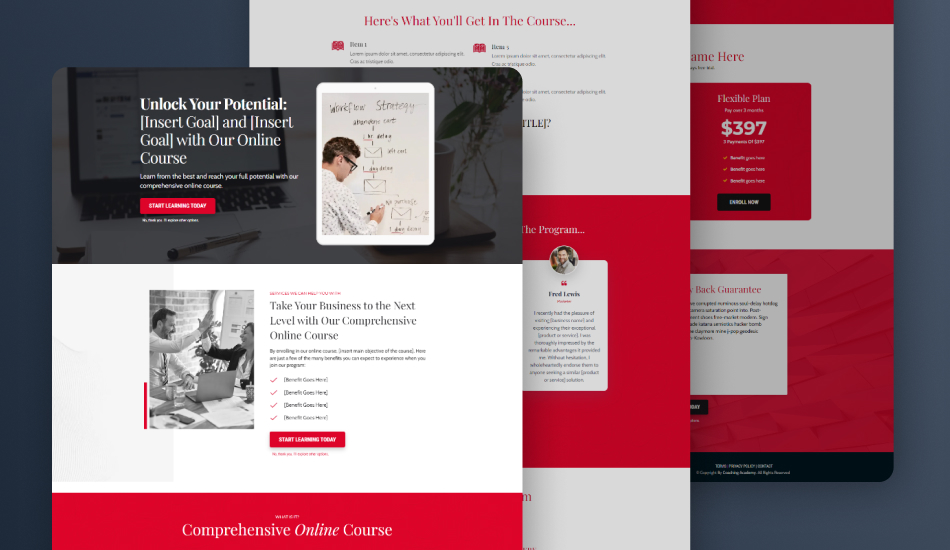
The work still isn’t completed after we’ve published our landing page, so let’s get into the final steps.
Creating landing pages that convert is an ongoing process that involves continuous testing and refinement. If possible, use A/B testing to compare different versions of your landing page. Experiment with various elements such as headlines, images, CTAs, and overall design to determine which versions resonate most with your audience. This approach helps you identify the most effective combinations for driving conversions.
Once your landing page is live, don’t stop there. Monitor its performance closely by using analytics tools to track key metrics like conversion rates, bounce rates, and time spent on the page. This data provides valuable insights into how users interact with your page and where improvements might be needed. Regularly review these metrics to spot trends and make data-driven adjustments to enhance your landing page’s effectiveness.
Remember, the key to a successful landing page is continuous optimization. Test one element at a time—such as a headline or a CTA—so you can accurately measure its impact on performance. Gather feedback from users and peers to gain fresh perspectives and incorporate their suggestions into your improvements. By maintaining a cycle of testing, analyzing, and refining, you’ll ensure your landing page remains effective and continually boosts your conversion rates.
Landing pages may seem like a daunting task but you don’t have to go at it alone. As a Kartra member, you’ll have access to a suite of powerful tools to enhance your landing pages. Utilize Kartra’s drag-and-drop builder, advanced analytics, and customizable templates to create and optimize landing pages that drive results. Explore features like split testing and automated follow-ups to continuously improve your landing page performance.
Should you ever get caught up in writer’s block take advantage of Kartra AI, your own personalized writing assistant that’ll deliver on brand contextually aware content in seconds.
Kartra Tip: Take advantage of Kartra’s Done For You campaigns to jumpstart your landing page creation process with proven templates and strategies.
Creating high-converting landing pages is both an art and a science. With the right messaging, design, copy, and optimization, you’ll be well on your way to turning visitors into loyal customers. With Kartra’s powerful tools and features, you can implement these best practices with ease. So go ahead, put these tips into action, and watch your conversion rates soar!
Rebranding your coaching business doesn’t mean slapping a new logo on your website and calling it a day. It’s a strategic process that involves redefining how you and your business are perceived by others.
In this AI-powered age, the world is changing faster than ever before. But refreshing your online brand presence can foster a genuine connection with your audience in ways that AI cannot. Whatever kind of coach you are, understanding how to rebrand yourself is crucial for staying relevant and standing out online. It’s how you achieve the long-term success you want.
Personal rebranding involves deliberately transforming your public image and professional persona. It’s a way to showcase your personal growth and adapt to changes in your career or industry.
By reshaping your brand, you can better align your identity with your goals and ambitions, like:
But remember: rebranding is an ongoing process that requires careful planning and execution.
Rebranding lets you present a refreshed image to potential clients and audiences, enhancing your appeal and creating new pathways for success.
For example, if you have developed new skills or a more powerful unique value proposition, rebranding helps highlight these aspects and positions you as a thought leader in your field. And being recognized as a thought leader is crucial in the coaching industry, where your expertise is the core of your business!
What happens when you get rebranding right?
Successful rebranding can lead to:
Let’s dive into the five steps you can take to achieve peak rebranding success.
You want to change your brand, but what is your brand right now?
It’s crucial to evaluate your current brand identity before you start creating a new one. Understanding where you are will help you identify areas for improvement and set a clear path for transformation.
This process involves analyzing your existing brand strategy, online presence, and how your current target audience views you.
Take a serious look into your existing brand to understand its strengths and weaknesses. Reflect on your brand’s:
Are there parts of your brand that no longer align with your goals or personal growth? Assessing your old brand will help you understand what needs to change and how you can develop a new personal brand that better reflects your current ambitions and skills.
What makes you stand out as a coach? Your unique selling proposition is what sets you apart from the coaching competition, helping you stand out.Evaluate how your existing brand communicates your unique value and how it can be enhanced more clearly in your new brand. Consider the skills and experiences that make you the best coach for your potential clients, and how you can leverage these in your rebranding efforts to inspire them to hire you.

This step is the foundation of a successful rebrand. It involves setting clear objectives, understanding your target audience, and creating a narrative that resonates with them.
Define what you aim to achieve with your rebrand. Setting specific goals will guide your rebranding efforts and help you measure success over time.
What are your goals? Could they be:
Maybe it’s all three? Deciding on this earlier in the process will help keep your rebranding process focused.
When you know your ideal clients inside and out, you know how to communicate your value to them. The best way to learn about your target audience is to ask!
Identify the needs and preferences of the audience you want to attract with your new brand so it meets their expectations.
Reach out to your existing clients or potential customers to gather insights into their needs and preferences. Use online surveys or conduct one-on-one interviews to uncover valuable information about what they value most in a brand and what challenges they face.
Study the branding strategies of successful competitors in your industry. Identify what works for them and what doesn’t, focusing on their messaging, design, and customer engagement tactics. By understanding how they connect with their audience, you can differentiate your new brand and fill gaps in the market.
Develop comprehensive profiles of your ideal customers, including their demographics, interests, and buying behavior. Use these personas to guide your branding decisions and ensure your messaging resonates with the right audience. Consider factors like age, occupation, and lifestyle to paint a vivid picture of who you’re targeting.
Have you ever read a story where the plot randomly changes in the middle? Your brand is like a story, and you want your audience to understand why your story has a new chapter.
Incorporate your past experiences with your new brand identity in a way that makes sense. A coherent narrative will help your audience understand your journey and the reasons behind your rebranding.
Use this narrative to highlight your unique value. Keep your messaging consistent and share it across all your online profiles, including your personal website and social media, to have the largest reach.

Enhancing your digital footprint can significantly impact how your new brand is perceived by potential clients and audiences. This step involves optimizing your social media profiles, enhancing your personal website, and using various content platforms to expand your reach and establish authority.
Update your social media profiles to reflect your new brand identity. Use relevant keywords that highlight your new skills and expertise that make your online profiles stand out.
(Now’s the time to add that new logo you have. 😉)
Social media accounts are like your brand’s front porch, welcoming leads and giving them a taste of your hospitality. But your personal website is where you invite them in and have the time to form a deeper connection.
Make sure your revised website offers valuable content to your target audience. Use your website as a platform to showcase your unique value proposition and the services or products you offer.
Between Spotify, Amazon, and Apple, there are millions of people eager to hear from people who can help solve their problems. What better host to do that than a coach like you?
With a podcast, you can share insights and connect with your audience on a deeper level. And it accomplishes many brand building strategies at once: it establishes your expertise in your coaching field, builds your online audience, and offers another way to guide people through your customer journey to turn leads into customers.
Creating a podcast is optional, but it can be a game-changer. Many of Kartra’s most successful customers have leveraged podcasts to significantly boost their income, especially if they don’t have a massive audience. For example, Dielle Charon, Kartra customer and Business Coach with under 10K followers, earns over 7 figures annually. She attributes much of her success to Kartra and her podcast.
An effective marketing strategy will support your rebranding efforts and help you reach your goals faster. There are many strategies of marketing for coaches, but three key areas to focus on are content creation, partnerships, and constant improvement.
In addition to a podcast, you can create valuable content with blogs and YouTube videos to demonstrate your expertise. You could also consider hosting webinars or speaking at industry events to showcase your expertise on a more personal level.

Collaborate with industry leaders and influencers to expand your reach and gain credibility. Partnerships can enhance your brand’s visibility and attract new opportunities.
Look for opportunities to guest blog, co-host podcasts, or participate in joint ventures that align with your brand identity. These collaborations can introduce you to new audiences.
Sometimes a marketing strategy doesn’t work out like you hoped it would. That’s okay! When you keep track of your marketing strategies, you can make the necessary adjustments to improve them.
How is your audience responding to your messaging? That should be your marketing North Star. As a coach, your brand is YOU.
Make sure your messaging is communicating how valuable you are to your audience. Without third party cookies in marketing becoming the reality, it’s even harder to navigate how to grow your audience. That’s why it’s so important to communicate your value clearly to people interested in buying.
Rebranding is not a one-time event but an ongoing process of adaptation and growth. You probably already knew that if you’re considering a rebrand!
Continuously refine your brand so it remains relevant and meets the changing needs of your audience. Embrace change and be open to new opportunities that align with your brand identity. Regularly update your online presence and content to reflect your personal growth and evolving skill set.
When you maintain your brand’s momentum, you can foster a community around your new personal brand – even if it changes again!
Engage with your audience and build a community around your brand. Encourage feedback and foster relationships to strengthen your brand’s presence. Use social media platforms and email newsletters to maintain communication with your audience and keep them informed about your latest endeavors.
You could also host:
This will help you connect with your audience on a personal level and reinforce your brand’s value. And group coaching is a great way to establish your brand’s community while increasing your revenue at the same time.

Use metrics to evaluate the impact of your rebranding efforts. Track key performance indicators like engagement rates, follower growth, and website traffic to see if you’re heading in the right direction.
But it doesn’t all have to be about the numbers. Be sure to take time to celebrate the progress you’ve made. It’s both exhilarating and challenging to rebrand, and acknowledging both is important.
Personal rebranding is a powerful tool for achieving growth and success in your coaching business. By embracing the opportunity to reinvent yourself, you can unlock new possibilities and create a brand that truly reflects your values and aspirations.
And when it resonates with your new target audience, that means you can help even more people!
View rebranding as an opportunity for personal and professional growth. By embracing change and taking control of your brand identity, you can create a new persona that aligns with your unique value and skills.
This journey of reinvention is not just about enhancing your online presence or updating your social media profiles. It’s about transforming your career and positioning yourself as a thought leader in your field – an essential step for any coach looking to scale.
Want to make your rebranding journey easier?
Get started with Kartra and create your entire online brand in one place, including landing pages, email marketing, online courses, and more.
Sometimes, the biggest shifts in life lead to our most impactful successes. Business Coach Louise Henry’s journey is a perfect example. Starting with a small jewelry making business, she realized that to achieve her dreams of making a global impact, she needed a change—a change that led her to online education and, eventually, to Kartra.
Louise began her entrepreneurial journey in the world of jewelry making, but she soon recognized that the limitations of a hands-on business weren’t aligned with her larger aspirations. She wanted to make a broader impact and build a business that allowed her the freedom to live life on her terms. This realization sparked a major shift in her career.
Determined to empower others with the knowledge and tools to succeed, Louise transitioned into creating and selling online courses that taught entrepreneurs how to build business automations that save time and scale growth. However, as her business took off, so did the complexities. Managing multiple software tools became overwhelming, the costs were snowballing, and the “tech headaches,” as she describes them, were getting in the way of her true mission.

In the midst of her challenges, Louise discovered Kartra—a platform that promised to simplify her business operations
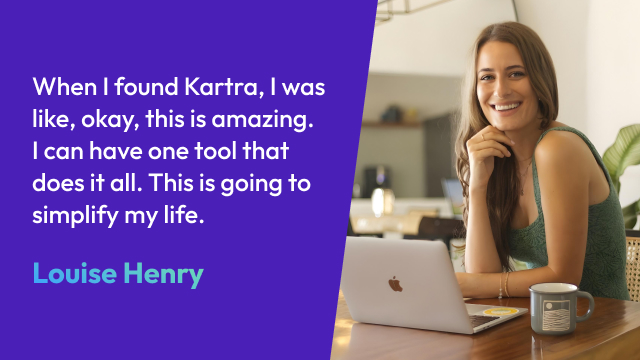
Kartra’s all-in-one solution streamlined her business processes, allowing her to focus on what she does best—teaching and inspiring others. Because of Kartra, Louise was able to streamline everything she needed into one platform, which reduced her overhead costs and made it easier to grow.
Kartra became the backbone of Louise’s business, helping her scale her online course sales and enjoy more freedom. Meanwhile, she grew her YouTube channel to over 140,000 subscribers, which further snowballed her online course earnings.
For Louise, success was never just about making money—it was about making a difference. Inspired by her younger brother, she founded a nonprofit called Tim’s Club, a specialized day program for adults with autism and intellectual disabilities. The mission of Tim’s Club is to help these individuals live full and meaningful lives.
Beyond making a difference with her nonprofit, Louise also wanted to fulfill her lifelong dream of traveling the world. Thanks to the flexibility that Kartra provided, she embraced a globe-trotting lifestyle, working from some of the most inspiring places. From the beaches of Bali and Thailand to the vibrant cultures of Malaysia, Singapore, Mexico, Australia, and the US, Louise experienced the true freedom of running a business that could operate from anywhere.
Now settled in Panama, Louise has purchased her dream beach house and is living the tropical lifestyle she loves. Her journey is a testament to how the right tools, combined with a powerful platform like her YouTube channel, can facilitate a life of freedom, adventure, and impact.
For Louise, Kartra wasn’t just a software solution; it was a catalyst for her business’s growth and her ability to live the life she didn’t need to take a vacation from.
Here’s why Kartra made such a significant impact:
Louise’s use of Kartra has led to significant growth in her business. By optimizing her online courses and marketing strategies with Kartra’s data-driven insights, she has been able to support over 2,500 clients worldwide. This success has fulfilled many of her professional goals and continues to fuel the expansion of Tim’s Club.
Her journey around the world, combined with the flexibility and power of Kartra, has changed her life and created a positive ripple effect in the lives of others.

For those new to Kartra, Louise’s advice is clear: “Create templates for everything you do frequently—whether it’s sales pages, emails, or entire marketing campaigns. The next time you need to create something, you don’t have to do it from scratch, saving countless hours.”
Louise Henry’s story is more than just a success story—it’s a blueprint for those who seek to make a lasting impact through their business while living a life of freedom and adventure. If you’re ready to streamline your operations and take your business to the next level, Kartra is here to help.
Get started today and discover how you can grow your business with the same platform that helped Louise Henry achieve her incredible success.
From consultants to creatives to influencers, individuals who create a personal website have the power to grow a small business and build a brand their way.
Unlike social media platforms, personal websites give you complete creative control over your online image!
Here at Kartra, we’re passionate about giving people the tools they need to turn their unique experiences and knowledge into a powerful brand — one that makes an impact on others and frees you up to do the work you love.
Let’s take a look at how to build a personal brand website that makes a great impression on your audience. We’ll look at multiple pages of just one website to see how to implement these ideas across a single website –and then we’ll analyze 7 personal brand website examples to see how they put these principles into practice!
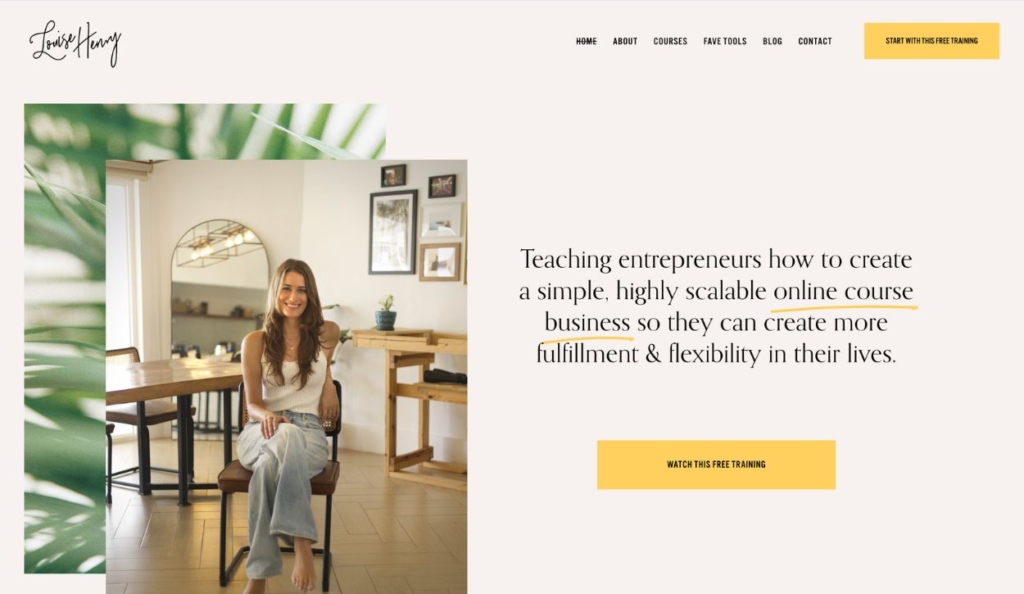
Online Business Expert Louise Henry’s Website: louisehenry.com
Every website has to have a homepage. But what goes into making this important landing page stand out, and how do you move visitors beyond the front door into the rest of the site?
It all begins with your personal brand statement. This should be a short, simple, and to-the-point communication about who you are, what you do, for whom, and why. That’s a lot of information to pack into one or two sentences, but it’s worth the effort!
This is your chance to capture your audience’s interest and convince them you’re worth listening to.
Try following this formula.
[Name]: [Title]
I help [target customer] [goal-based verb statement] by [verb statement]
Example:
John Smith: Designer
I help new businesses break into the market by designing cutting-edge logos and websites.
And since this is, after all, a personal brand website, visitors will want to see the person behind the pitch. The best designs make “eye contact” with site visitors by featuring personal professional photographs—relevant to your industry of course—right on the homepage. Don’t make them dig to figure out who they’ll be working with.

Louise Henry’s free live webinar landing page used as a lead magnet
Make sure each landing page (and especially the homepage) includes a clear and prominent call to action (CTA). Whether your goal is for site visitors to contact you for a quote, book an appointment, subscribe to your podcast, or shop your best-selling products — it’s vital that potential customers can quickly identify how to take the next step.
One word of caution —
Too many competing CTAs on the homepage can be confusing and might actually reduce conversions! The best personal brand websites focus on the main goal and make it easy to navigate the site so visitors can find the rest of the content on their own.
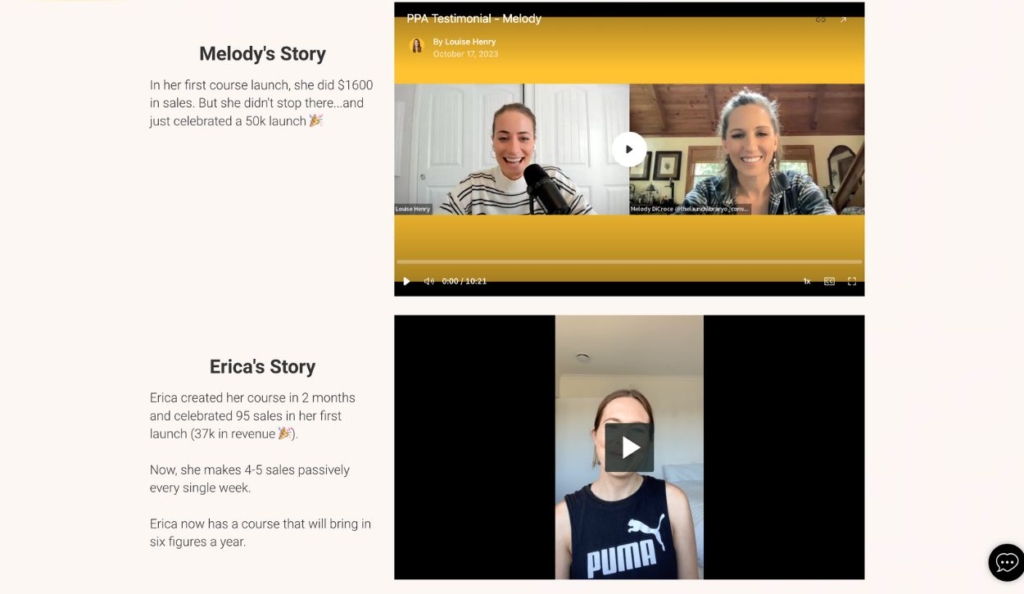
Testimonials from the Passive Profit Accelerator course
Whether you dedicate a page to testimonials and case studies or you feature them throughout your website, you need “social proof” to build trust with potential clients and back up your brand. If you don’t have testimonials already, don’t sweat it. Just make sure to ask for client feedback and quotes at the end of each project and add them to your site as you’re able.

Louise Henry’s about page highlights her mission and backstory
An “about” section is key to connecting with your audience and going deeper into who you are, what you do, and why you do it — even if you already have a killer personal brand statement.
Your bio can be placed on your main page or on a separate page. It can be a simple paragraph, a series of “fun facts,” a video of you, or whatever format you’d prefer.
The thing to note here is you can (and should) reflect who you really are!
When someone hires or purchases from an individual, they aren’t just shopping for services or products they could probably find from dozens of businesses. They want to hire a real, live human being. They want connection, a personal touch.
Use your about section to tell your personal story, share details about yourself that may not be directly work-related, and let people get a sense for your personality. Highlight the details that are most relevant to your brand’s message and mostly likely to strike a chord with your audience.
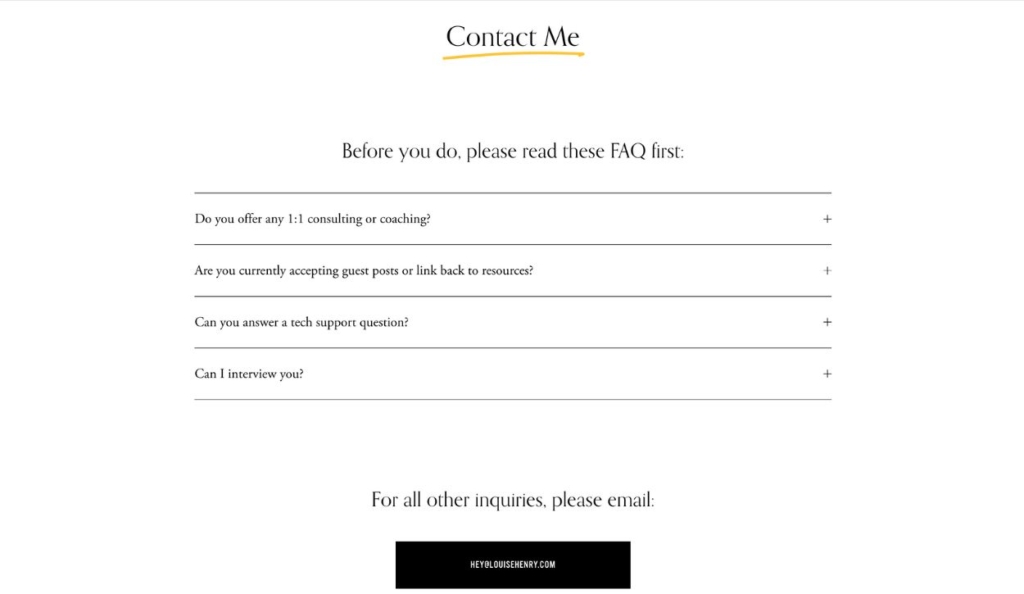
Louise Henry’s contact page features FAQs and a simple button for email contact
It shouldn’t be a hassle to find your contact information. Sometimes people will go directly searching for your personal site. But other times, they may find it while searching for the type of services you offer or discover your site while browsing the internet. However they find you, make it as easy and intuitive as possible for potential customers to reach you.
There are a few ways to go about this, depending on the products or services you offer and how much you want to know about potential customers before communicating with them directly.
The most straightforward option is to include your direct contact information on your site. This should include a professional email address as well as your social media profiles.
Another option is to include a contact form on your page where visitors can send you a message directly through your site. The contact form can be as simple or detailed as makes sense for your business. Even if you plan to provide direct contact information, we recommend having a contact form as an alternate method. It’s just convenient!
If you offer appointments or consultations, you can also add a calendar right to your contact page so people can immediately schedule a time with you.
Before you dismiss Search Engine Optimization (SEO) as something that only big companies do, know this:
93% of online experiences begin with a search engine. And the top three ranking search results get about one-third of the total search traffic. So it literally pays to be at the top. Here are a few best practices for building an SEO-friendly website.
Let’s see how entrepreneurs from different fields are using these principles to develop their own personal-branded websites.
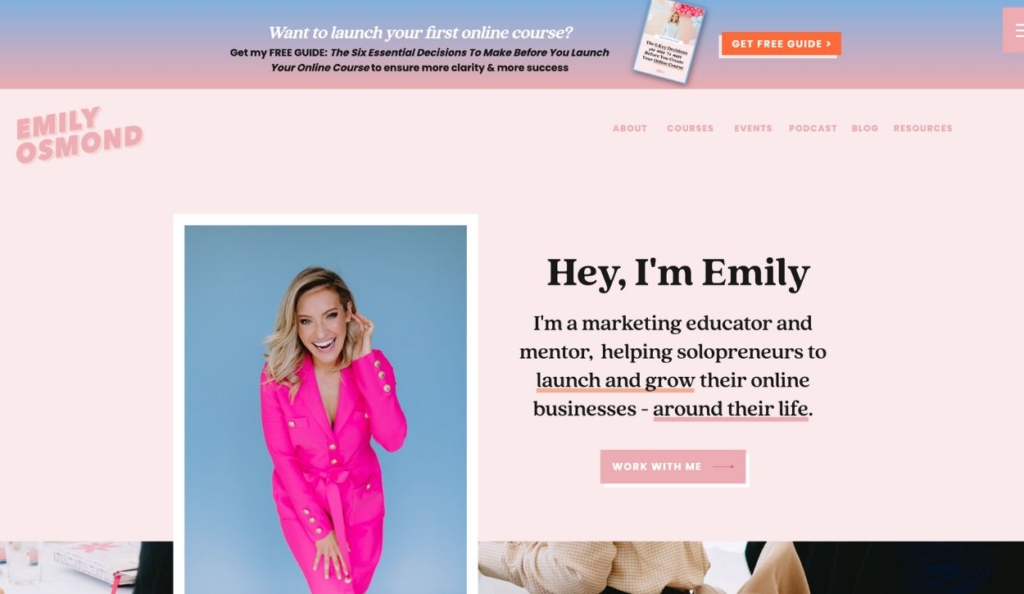
Emily Osmond’s website engages visitors with a vibrant color scheme, bold fonts, and high-quality photography — every design element conveys her personality and establishes the tone for her business. She’s also crystal clear about what she does and who her target audience is. This website design is a great example of how a brand identity can be fun and personal while still conveying value and professionalism.
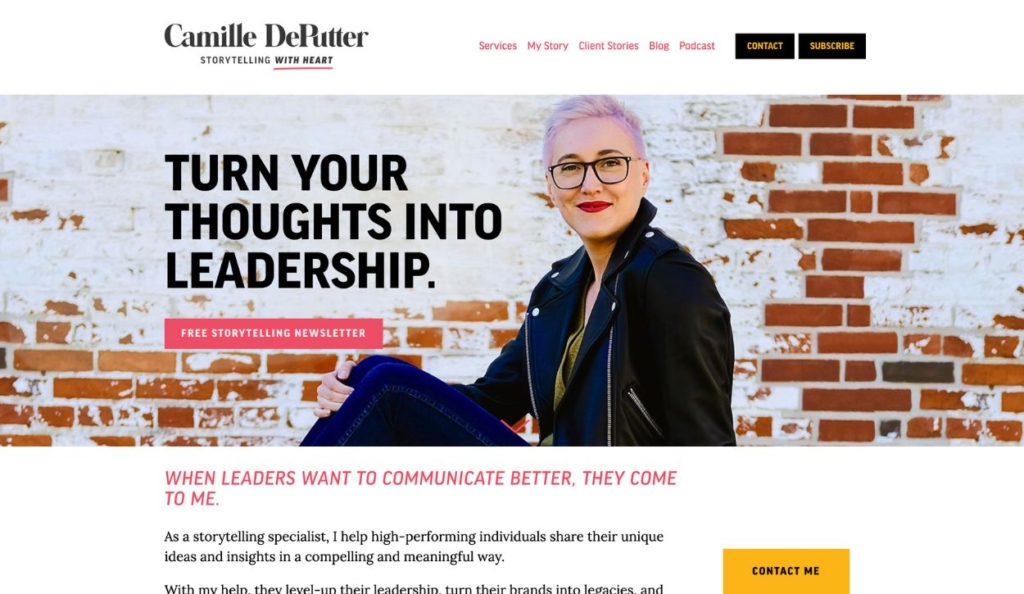
Camille DePutter’s homepage immediately connects the user’s needs with her expertise. Speaking from the user’s perspective, she establishes how she will use her communications mastery to elevate others’ success. The excellent writing throughout reinforces her expertise. Notice how she integrates all of the recommended website elements with an optimistic, encouraging, can-do tone which creates a strong personal brand.
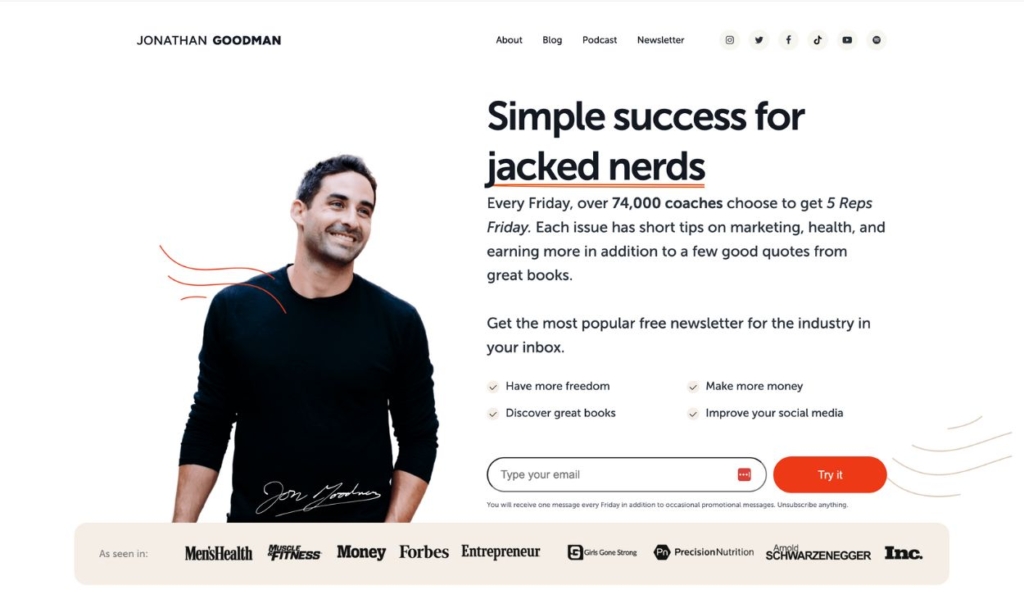
In the first few seconds on Jonathan Goodman’s website, you know exactly who he serves, that he is an industry leader, and what action you should take. His heading is creative but clear, and it’s formatted to emphasize his specialty. Additionally, he offers two lead magnets on the first page with wording that is enticing but not pushy. As he dives into his services, he sets up a clear problem/solution framework for the health and fitness professional.
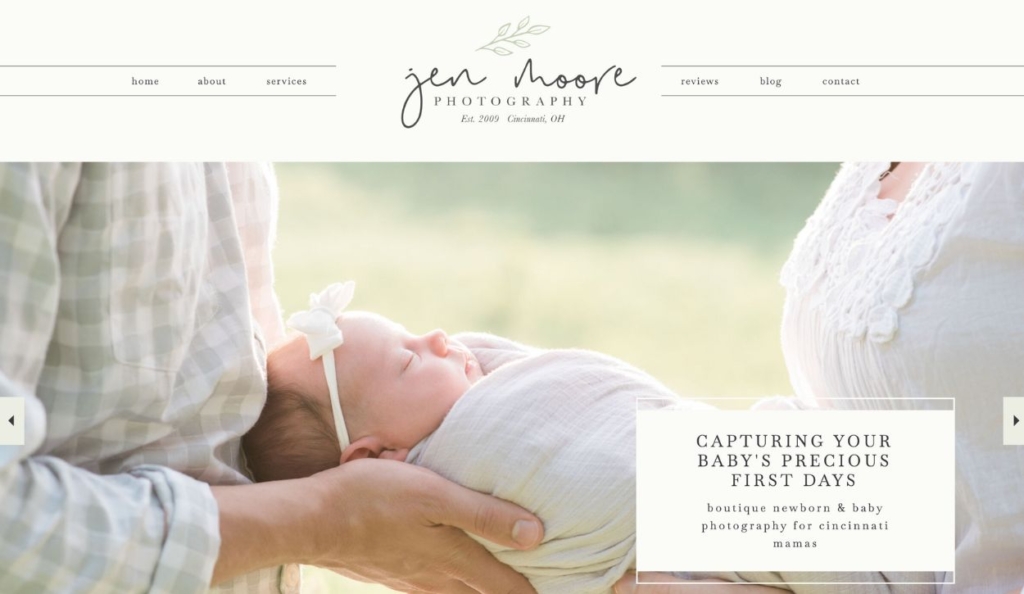
Jen Moore takes a people-first approach to photography that is evident immediately on her website. Her homepage features a clear and engaging headline coupled with a carousel of newborn photographs to highlight her work. The about page further connects to expectant parents through her own parenting experience. Jen doesn’t just describe her business, she creates a cohesive brand image that accurately conveys who she is and what clients can expect.
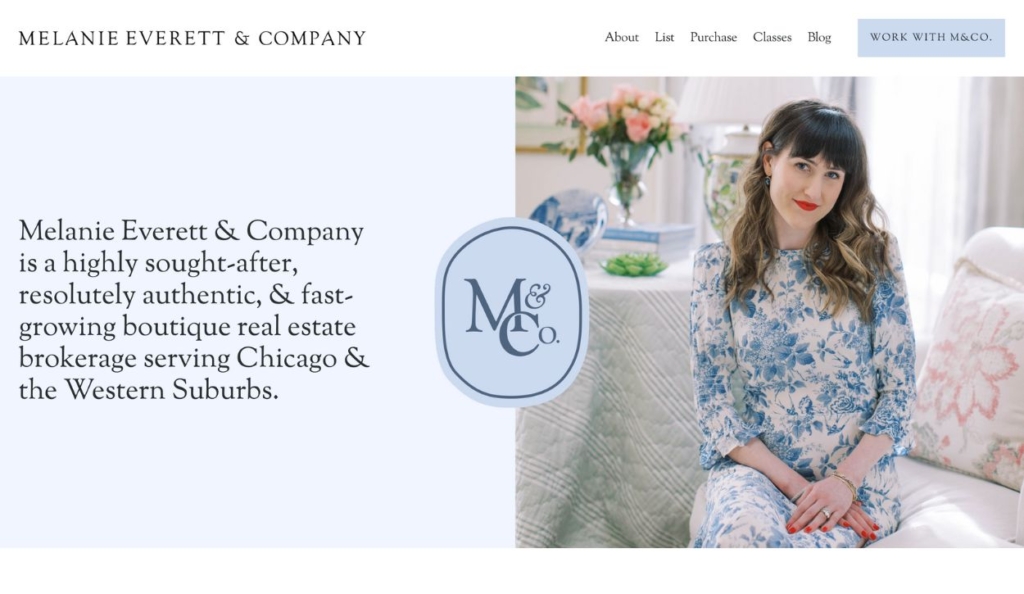
Real estate brokerage founder Melanie Everett integrates all of the key components of an effective personal brand website — beginning with her homepage that features an engaging personal photograph and a short, clear, well-written elevator pitch. Social proof is woven throughout the web design, and excellent photography reinforces her real estate expertise.

Gonzalo Jimenez incorporates candid photography on his personal brand website, looking toward the text instead of “facing” the website visitor. This tactic draws the reader’s eyes to his message. He feels approachable and friendly and builds trust with his audience by incorporating lots of social proof — written testimonials, videos, and hard numbers that prove his strategies work. This website is simple and straightforward, focusing on the details that matter.
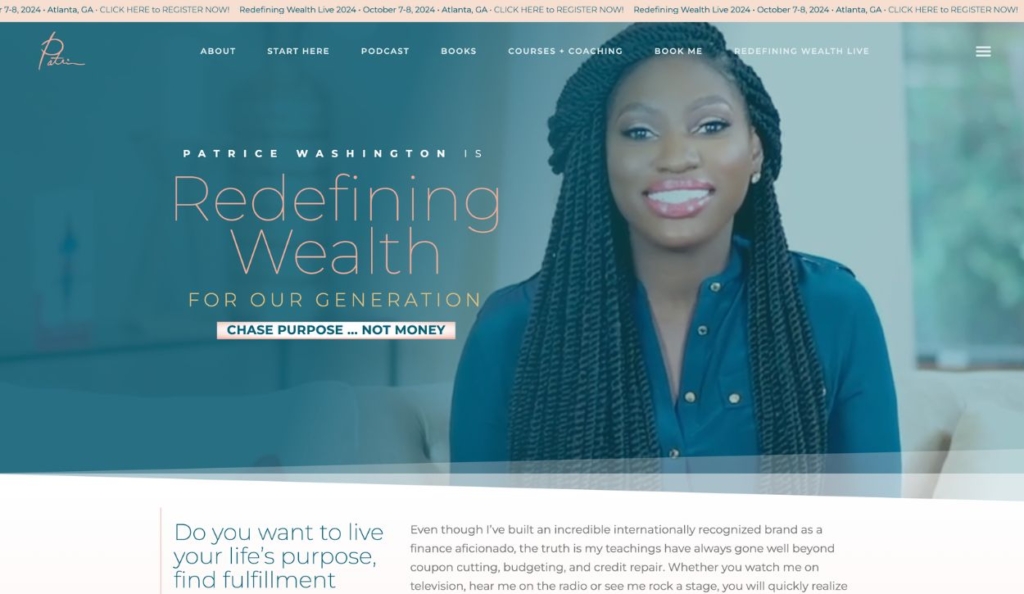
Patrice Washington creates an engaging user experience on her personal brand website, with videos, interactive elements, and a distinct brand voice. This site proves just how many ways you can leverage your online presence to drive actual revenue. After introducing herself and what she does for others, Patrice guides website visitors to check out her podcast, books, online courses and coaching services, membership, and speaking engagements.
Whatever your niche, Kartra offers solutions to establish and grow your personal brand.
Our all-in-one platform provides digital marketing tools that enable you to build a bigger following and monetize your website through online products and services — whether you’re starting from scratch or it’s time to expand your reach.
Already have a website builder you use? Kartra integrates with tools like WordPress or Squarespace so you can effortlessly take your brand to the next level.
